Physical Address
304 North Cardinal St.
Dorchester Center, MA 02124
Renal ultrasound is the screening modality of choice for the initial evaluation of renal insufficiency. Relevant imaging markers include parenchymal echogenicity, renal length, and collecting system dilatation.
The primary role for ultrasound in the evaluation of renal masses is to differentiate between cystic and solid lesions, although an appropriate differential diagnosis may be given based on clinical history and cyst complexity.
Echogenic renal masses are problematic, and although several discriminatory features have been proposed, renal computed tomography or magnetic resonance imaging is typically employed for larger lesions to differentiate between renal cell carcinoma and angiomyolipoma.
The role of ultrasound in the evaluation of hematuria continues to evolve. Ultrasound is an effective screening modality for typical “urologic” causes of hematuria (namely, renal calculi) in younger patients.
Focal and diffuse bladder wall thickening at ultrasound is nonspecific and may be caused by a variety of infectious, inflammatory reactions or neoplastic processes. Urine analysis, clinical history, and potentially cystoscopy are typically performed after thickening is identified at sonography.
The prime function of the kidney is excretion of metabolic waste products. The kidneys do this by converting more than 1700 liters of blood per day into 1 liter of highly concentrated urine. The kidney is an endocrine organ that secretes many hormones, including erythropoietin, renin, and prostaglandins. The kidneys also function to maintain homeostasis by regulating water-salt and acid-base balance. The renal collecting system, ureters, and urethra function as conduits, and the bladder serves as a reservoir for urinary excretion.
Three sets of kidneys develop in human embryos: the pronephros, mesonephros, and metanephros (definitive or permanent kidney). The pronephroi appear early in the fourth embryologic week and are rudimentary and nonfunctioning. The mesonephroi form late in the fourth week and function as interim kidneys until the developing metanephroi begin to function (ninth week). The metanephroi (permanent kidneys) develop from two sources: the ureteric bud and metanephrogenic blastema. The ureteric bud forms the ureter, renal pelvis, calices, and collecting ducts, interacting with and penetrating the metanephrogenic blastema. This interaction is necessary to initiate ureteric bud branching and differentiation of nephrons within the blastema ( Fig. 9.1 ). Initially, the permanent kidneys are found in the pelvis. With fetal growth, the kidneys come to lie in the upper retroperitoneum. With ascent, the kidneys rotate medially 90 degrees so that the renal pelvis is directed anteromedially. The kidneys are in their adult location and position by the ninth gestational week. As the kidneys ascend, they derive their blood supply from nearby vessels; adult blood supply is from the abdominal aorta.
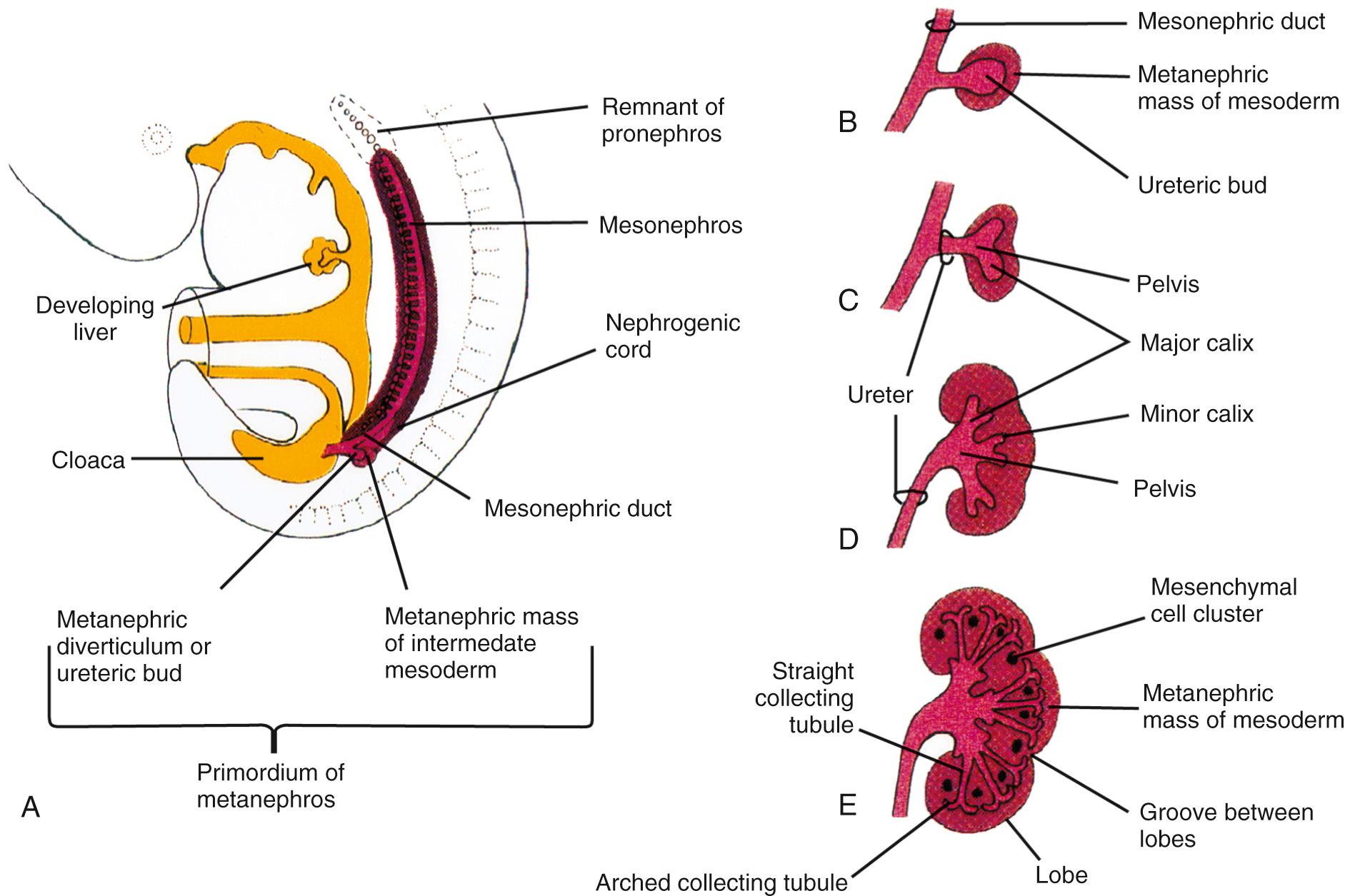
In the seventh gestational week the urorectal septum fuses with the cloacal membrane, dividing it into a ventral urogenital sinus and a dorsal rectum. The bladder develops from the urogenital sinus. Initially, the bladder is continuous with the allantois, which eventually becomes a fibrous cord called the urachus, the adult median umbilical ligament. As the bladder enlarges, the distal portion of the mesonephric ducts is incorporated as connective tissue into the bladder trigone. At the same time, the ureters come to open separately into the bladder. In infants and children the bladder is an abdominal organ; it is not until after puberty that it becomes a true pelvic structure ( Fig. 9.2 ).
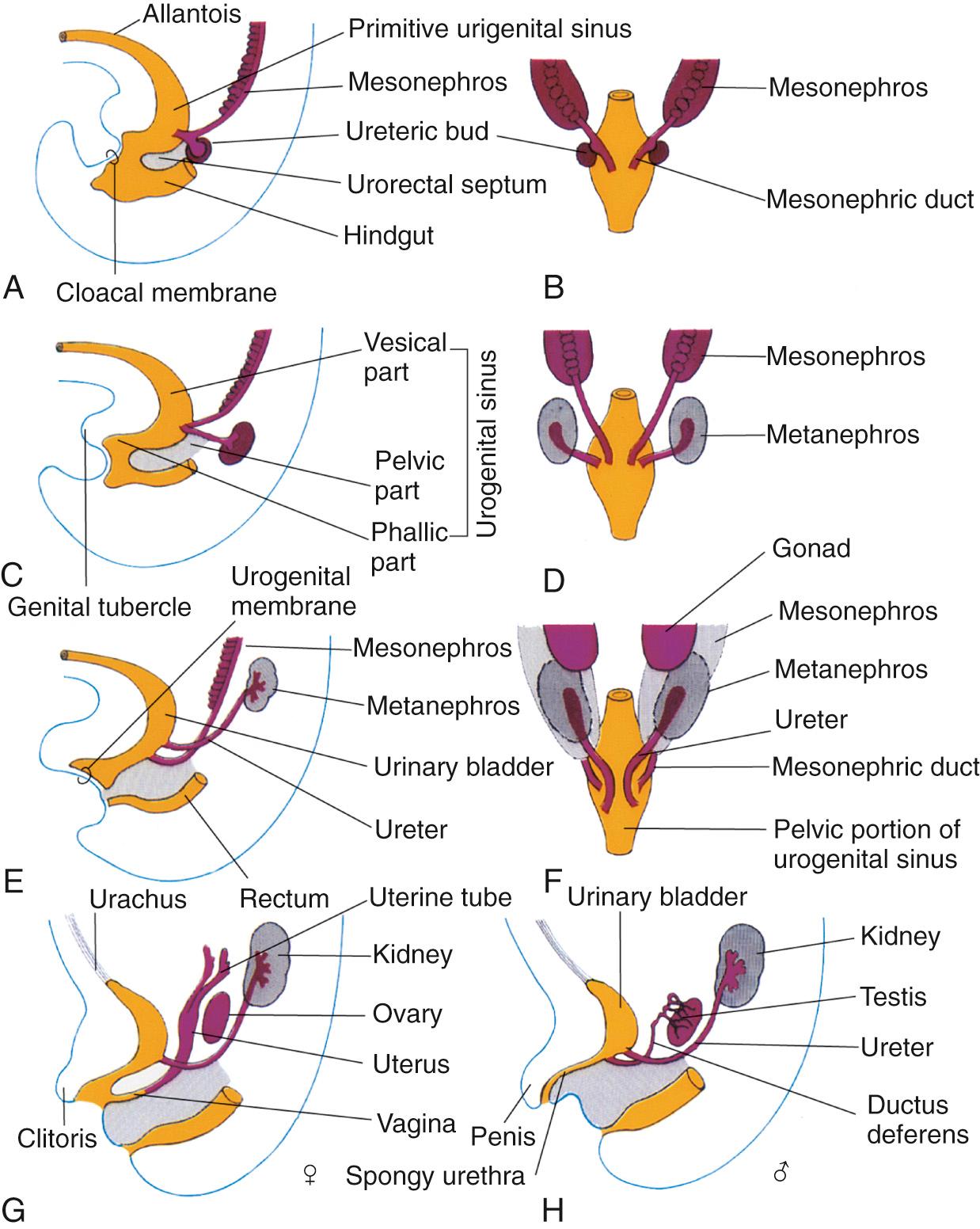
The epithelium of most of the male urethra and the entire female urethra is derived from the endoderm of the urogenital sinus. The urethral connective tissue and smooth muscle form from adjacent splanchnic mesenchyme.
In the adult, each kidney measures approximately 11 cm long, 2.5 cm thick, and 5 cm wide and weighs 120 to 170 grams. Emamian et al. demonstrated that the parenchymal volume of the right kidney is smaller than that of the left kidney, possibly because of a relatively larger potential space for left renal growth (growth of right kidney inhibited by liver) or relatively increased left renal blood flow (left renal artery typically shorter than right renal artery). Renal length correlates best with body height, and renal size decreases with advancing age because of parenchymal reduction.
The left kidney usually lies 1 to 2 cm higher than the right kidney. The kidneys are mobile and will move depending on body position. In the supine position, the superior pole of the left kidney is at the level of the 12th thoracic vertebra, and the inferior pole is at the level of the third lumbar vertebra.
The normal adult kidney is bean shaped with a smooth, convex contour anteriorly, posteriorly, and laterally. Medially, the surface is concave; the medial surface is known as the renal hilum. The renal hilum is continuous with a central cavity called the renal sinus. Within the renal sinus are the major branches of the renal artery, major tributaries of the renal vein, and the collecting system. The remainder of the renal sinus is packed with fat. The collecting system (renal pelvis) lies posterior to the renal vessels in the renal hilum ( Fig. 9.3 ).
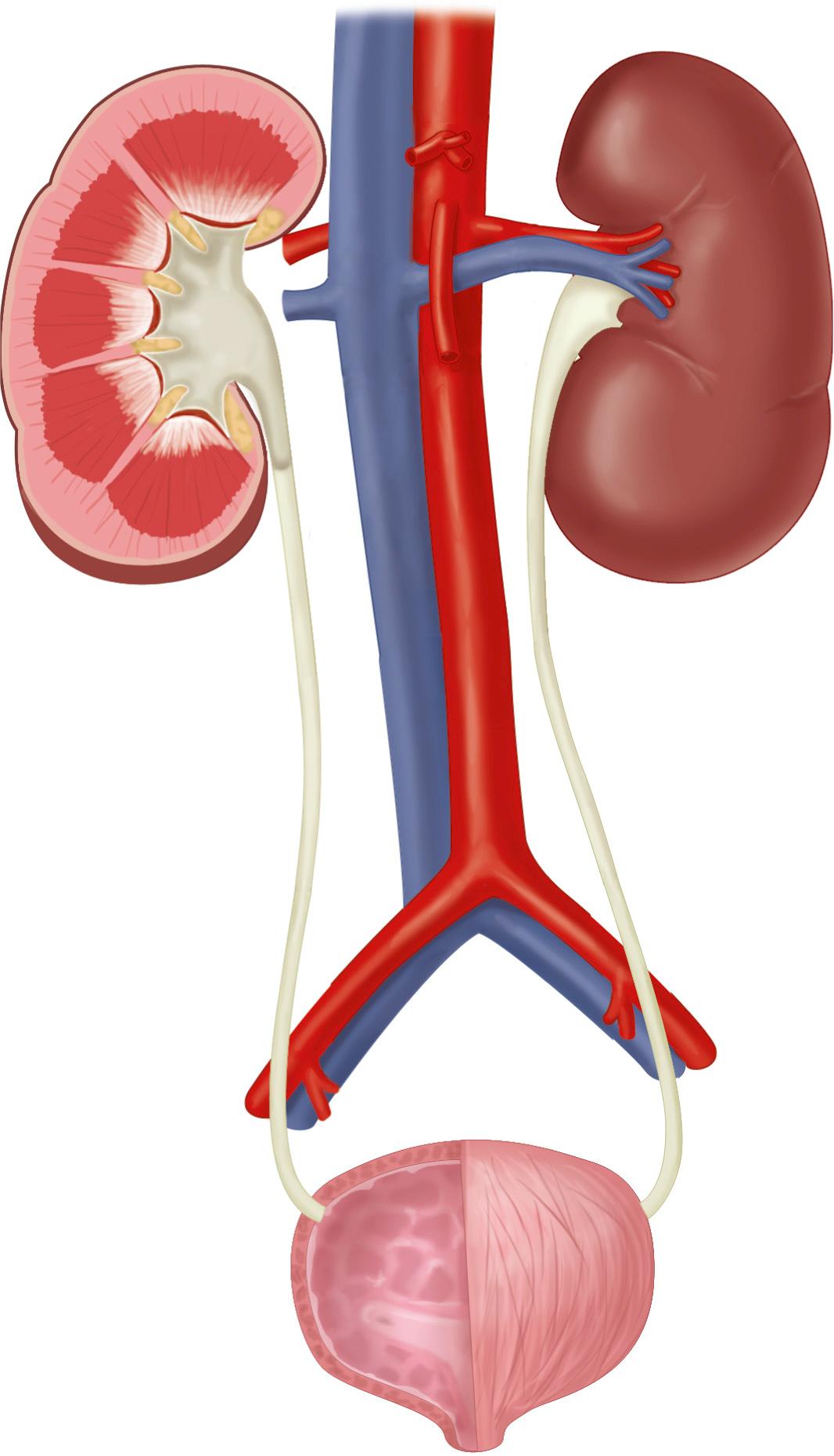
Renal parenchyma is composed of cortex and medullary pyramids. The renal medullary pyramids are hypoechoic relative to the renal cortex and can be identified in most normal adults ( Fig. 9.4 ). Normal renal cortex is typically less echogenic than adjacent liver and spleen. Platt et al. found that 72% of 153 patients with renal cortical echogenicity equal to that of the liver had normal renal function. Greater renal echogenicity than liver echogenicity showed a specificity and a positive predictive value for abnormal renal function of 96% and 67%, respectively. However, the sensitivity of this ultrasound criterion was poor (20%).
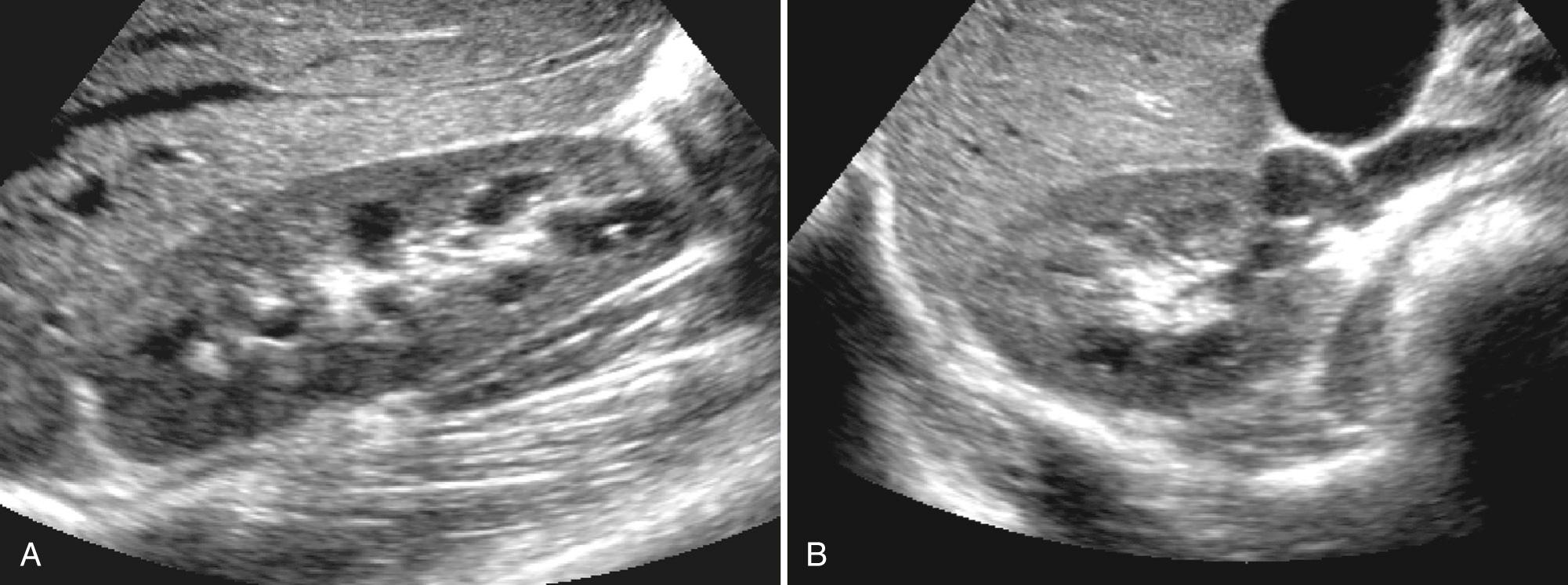
During normal development, two parenchymal masses called renunculi partially fuse. Parenchymal junctional defects occur at the site of fusion and must not be confused with pathologic processes (e.g., renal scar, angiomyolipoma). The junctional parenchymal defect is most often located anteriorly and superiorly, typically at the junction of the upper and middle thirds of the kidney, and can be traced medially and inferiorly into the renal sinus. Usually, it is oriented more horizontally than vertically and therefore it is best appreciated on sagittal scans ( Fig. 9.5 ). Junctional cortical defects are more often shown within the right kidney, although left junctional cortical defects may be detected with favorable acoustic windows.
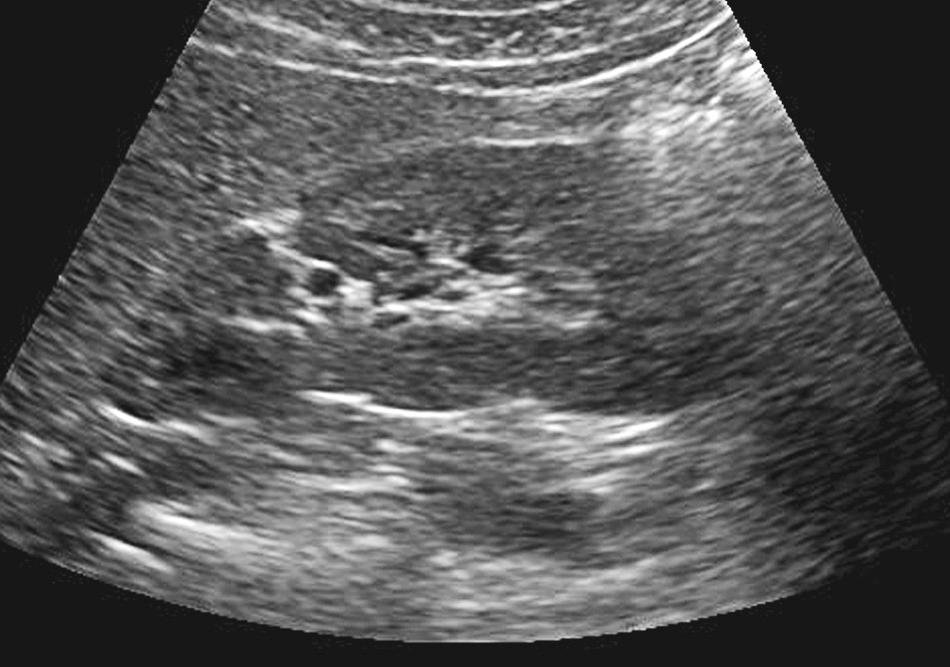
A hypertrophied column of Bertin (HCB) is a normal variant; it represents unresorbed polar parenchyma from one or both of the two subkidneys that fuse to form the normal kidney. Sonographic features that may aid in the demarcation of HCB include indentation of the renal sinus laterally and a border formed by the junctional parenchymal defect. Hypertrophied columns are usually located at the junction of the upper and middle thirds of the kidney and contain renal cortex that is continuous with the adjacent renal cortex of the same subkidney. Columns contain renal pyramids and usually measure less than 3 cm ( Fig. 9.6 ). The echogenicity of HCB and adjacent renal cortex depend on the scan plane. Alterations in tissue orientation produce different acoustic reflectivity. The echoes of the HCB are brighter than those of adjacent renal cortex when seen en face ( Fig. 9.6 ). It may be difficult to differentiate a small, hypovascular tumor from an HCB; however, demonstration of arcuate arteries by color Doppler ultrasound indicates an HCB rather than a tumor. Occasionally, contrast-enhanced computed tomography (CT) may be necessary to differentiate between an HCB and a non–border-deforming renal lesion.
Indentation of renal sinus laterally
Bordered by junctional parenchymal defect
Location at junction of upper and middle thirds
Continuous with adjacent renal cortex
Similar color flow to surrounding parenchyma
Contains renal pyramids
Less than 3 cm in size
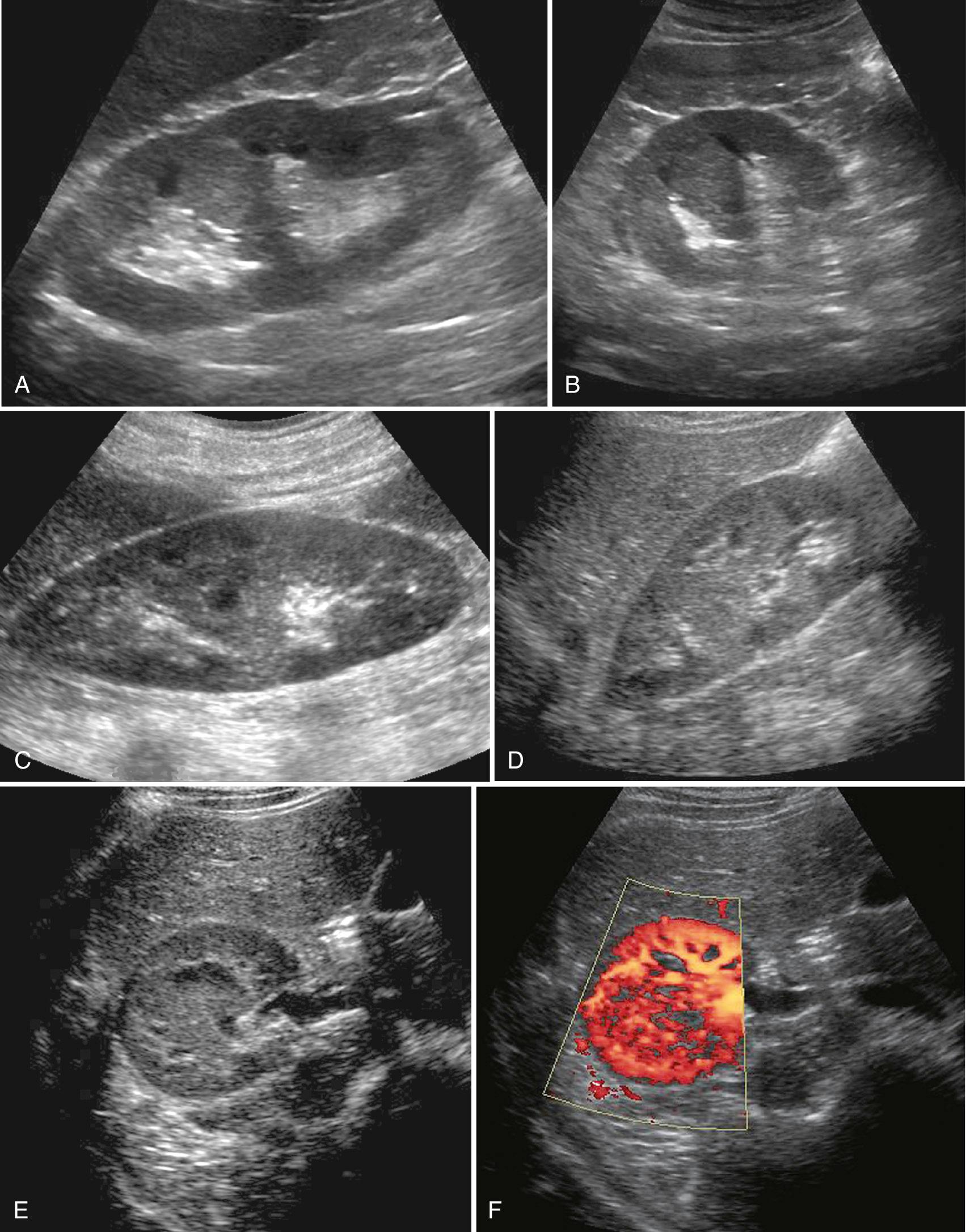
The kidney has a thin, fibrous capsule. The capsule is surrounded by perirenal fat. Perirenal fat is encased anteriorly by Gerota fascia and posteriorly by Zuckerkandl fascia. The right perirenal space opens superiorly at the bare area of the liver, and both perirenal spaces communicate with the pelvic peritoneal space. Right and left perirenal spaces communicate with each other across the midline at the level of the third to fifth lumbar vertebrae.
The ureter is a long (30-34 cm), mucosal-lined conduit that delivers urine from the renal pelvis to the bladder. Each ureter varies in diameter from 2 to 8 mm. As it enters the pelvis, the ureter passes anterior to the common/external iliac artery. The ureter has an oblique course through the bladder wall (see Fig. 9.3 ).
The bladder is positioned in the pelvis, inferior and anterior to the peritoneal cavity and posterior to the pubic bones. Superiorly, the peritoneum is reflected over the anterior aspect of the bladder. Within the bladder, the ureteric and urethral orifices demarcate an area known as the trigone; the urethral orifice also marks the bladder neck. The bladder neck and trigone remain constant in shape and position; however, the remainder of the bladder will change shape and position depending on the volume of urine within it. Deep to the peritoneum covering the bladder is a loose, connective tissue layer of subserosa that forms the adventitial layer of the bladder wall. Adjacent to the adventitia are three muscle layers: the outer (longitudinal), middle (circular), and internal longitudinal layers. Adjacent to the muscle, the innermost layer of the bladder is composed of mucosa. The bladder wall should be smooth and of uniform thickness. The wall thickness depends on the degree of bladder distention.
The ability to visualize organs of the genitourinary tract by ultrasound depends on the patient's body habitus, operator experience, and scanner platform. High-frequency probes should be used for patients with a favorable body habitus. Harmonic imaging is often useful for difficult-to-scan patients (e.g., obese patients). Compound imaging and speckle reduction may increase lesion conspicuity and decrease artifacts.
The kidneys should be assessed in the transverse and coronal plane. Optimal patient positioning varies; supine and lateral decubitus positions often suffice, although oblique and occasionally prone positioning may be necessary (e.g., obese patients). Usually, a combination of subcostal and intercostal approaches is required to evaluate the kidneys fully; the upper pole of the left kidney may be particularly difficult to image without a combination of approaches. When the collecting system is dilated, additional images should be taken to assess for the level of obstruction, any obstructing lesion, and appearance of the kidneys after voiding (see “ Hydronephrosis ”).
The proximal ureter is best visualized using a coronal oblique view with the kidney as an acoustic window. The ureter is followed to the bladder, maintaining the same approach. A nondilated ureter may be impossible to visualize because of overlying bowel gas. Transverse scanning of the retroperitoneum often demonstrates a dilated ureter, which can then be followed caudally with both transverse and sagittal imaging. In women, a dilated distal ureter is well seen with transvaginal scanning.
The bladder is best evaluated when it is moderately filled; an overfilled bladder causes patient discomfort. The bladder should be scanned in the transverse and sagittal planes. To better visualize the bladder wall in women, transvaginal scanning may be helpful. If the nature of a large, fluid-filled mass in the pelvis is uncertain, voiding or insertion of a Foley catheter will clarify the location and appearance of the bladder relative to the fluid-filled mass.
Incomplete bladder emptying can be due to prostate enlargement, neurogenic bladder, or pelvic floor weakness. Bladder stones and infection are important complications. Initial assessment includes assessment of the kidneys and ureter for dilatation, as well as calculation of both a prevoid and postvoid residual. We typically calculate bladder volume by taking the three orthogonal measurements and multiplying by .6 (this is different from most organs, which multiply by .52). This slightly larger value is because the shape of the bladder is more of a cuboidal shape than a prolate ellipse.
The urethra in a woman can be scanned with transvaginal, transperineal, or translabial sonography ( Fig. 9.7 ). The posterior or the prostatic urethra in men is best visualized with transrectal probes ( Fig. 9.8 ).
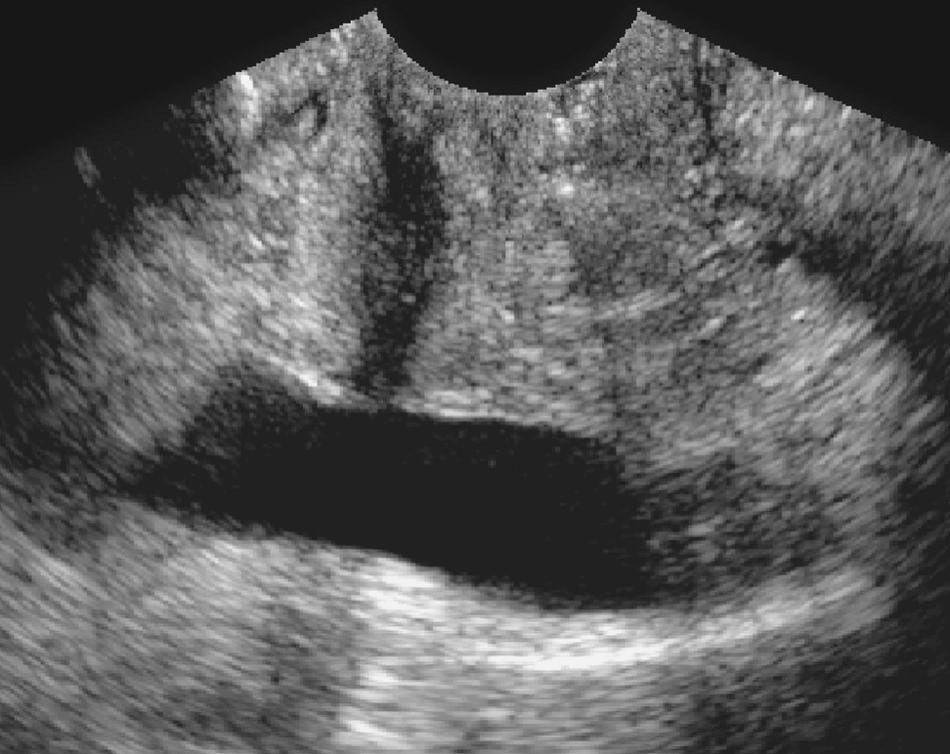
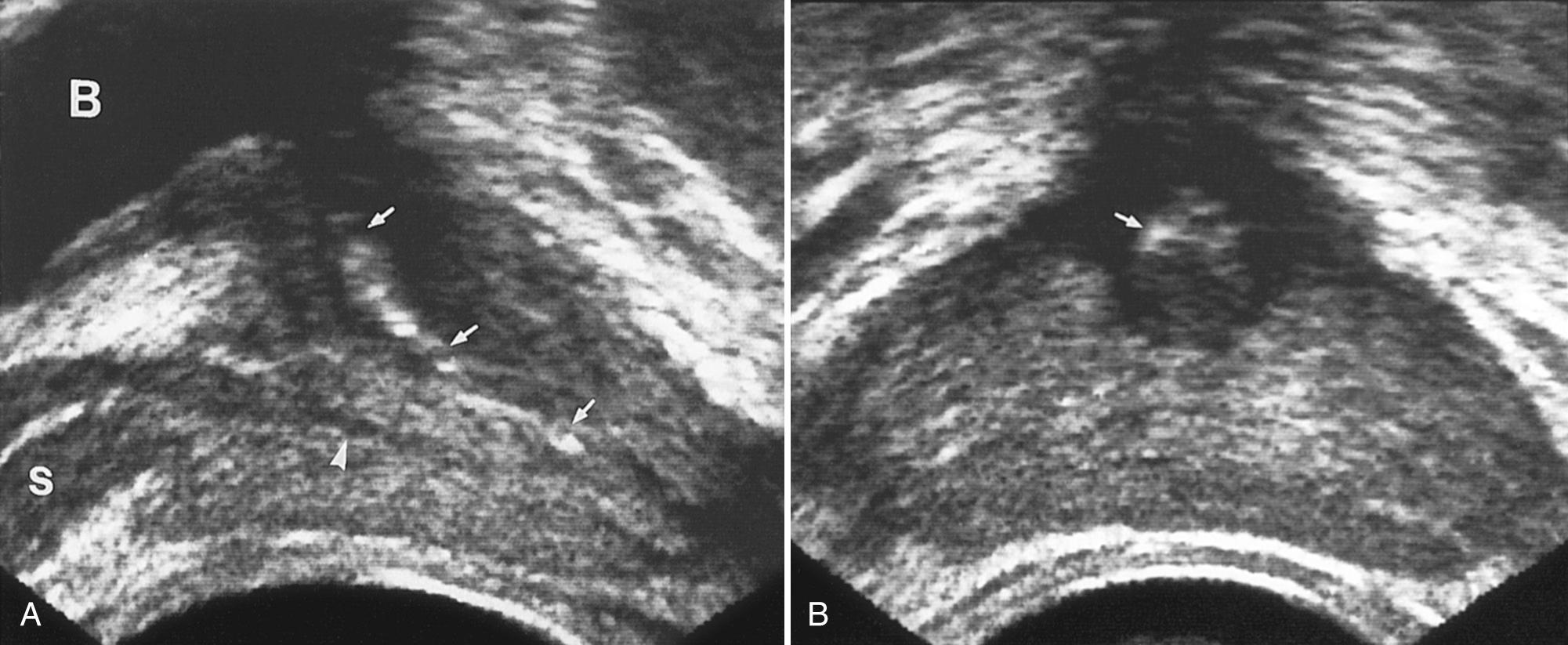
The term hydronephrosis refers to dilatation of the collecting system. Obstruction is often present, but this is not always the case. There are many causes of a dilated renal collecting system, and ultrasound is the initial imaging modality of choice for the majority of these assessments (except as discussed in the previous section where noncontrast-enhanced CT may be used in the initial assessment of acute renal colic). Initial sonographic evaluation should include an assessment of the degree of dilatation, appearance of surrounding renal parenchyma, assessment for level of obstruction and any obstructing lesion. Numerous grading systems for the assessment of the degree of hydronephrosis have been proposed following Ellenbogen and colleagues' original article on the topic. None has been readily adopted, however, and most radiologists continue to use descriptive terminology such as mild, moderate, and severe.
A practical pearl for the ultrasound evaluation of hydronephrosis is to assess the degree of dilatation before and after bladder voiding. Hydronephrosis that persists after voiding suggests an anatomic obstruction. If collecting system dilatation diminishes postvoiding, then one might consider nonobstructive pelvicaliectasis (i.e., vesicoureteral reflux). Most obstructing lesions are located within the pelvis (fibroids, prostatic hypertrophy, ovarian tumor, bladder tumor) and thus are obvious on sonographic evaluation. When the pelvis is normal, the length of the ureter should be assessed for dilatation and/or obstructing lesion. In pregnancy, it is helpful to have the patient lie in the decubitus position with the symptomatic side up to allow for the weight of the uterus to move off of the ureter.
| Genitourinary Obstruction | Comments |
|---|---|
| Renal/ureteral stone | Look for stone in common sites of obstruction: ureterovesical junction and ureteropelvic junction |
| Transitional cell carcinoma | Hematuria |
| Sloughed papilla | |
| Blood clot | Hematuria |
| Posterior urethral valves | Bilateral, pediatric diagnosis |
| Ureterocele | May be orthotopic or heterotopic If heterotopic, look for renal duplication abnormality |
| Ureteropelvic junction obstruction | Extrarenal pelvis may be dilated out of proportion to calices |
| Ureteral stricture (prior infection, surgery, radiation) | History aids in diagnosis |
| Neurogenic bladder | Check for postvoid residual |
| Extrinsic Obstruction | |
| Retrocaval ureter | May need CT for diagnosis |
| Prostatic hypertrophy | Enlarged prostate impinges on bladder |
| Tumor (fibroid, ovarian carcinoma, lymphoma) | Abnormal mass seen in pelvis |
| Lymphadenopathy | Abnormal mass seen in pelvis |
| Retroperitoneal fibrosis | Mass encasing the aorta CT may be needed for diagnosis |
| Aneurysm | Should be obvious on Doppler assessment of vessels |
| Endometriosis | Mass typically seen in pelvis |
| Pregnancy | Ureter dilated to pelvic brim |
| Nonobstructive | |
| Vesicoureteral reflux | Cortical scarring, typically in upper poles |
| Congenital megacalices | May be unilateral or bilateral If associated with congenital megaureter, both dilated ureter and calices will be present May need contrast-enhanced CT for diagnosis |
| Prior obstruction | Prior severe dilatation may not return to normal |
| Infection | Signs and symptoms of infection |
| High flow states (diabetes insipidus, psychogenic polydipsia) | Typically mild dilatation |
| Distended bladder | Returns to normal after bladder emptying |
Over time the obstructed kidney will initially become enlarged. Later, renal damage may occur with parenchymal atrophy and blunting of calices.
In pregnancy, the urinary tract frequently is dilated. Smooth muscle relaxation occurs as a result of elevated hormone levels. Mass effect on the ureter may be caused by the enlarged uterus. Because of the location of the ureters, the right ureter is frequently more dilated than the left ureter. Physiologic dilatation of the urinary tract in pregnancy is suggested when the distal ureters taper at the sacral promontory. Pregnant patients are also at increased risk for urinary tract infections (UTIs), which can complicate the assessment. In addition, stone disease can occur and this needs to be distinguished from the physiologic dilatation associated with pregnancy.
In acute hydronephrosis of pregnancy, patients may present with severe flank or lower abdominal pain radiating to the groin due to ureteric obstruction. The obstruction usually occurs at the level of the pelvic brim. Symptoms may improve with change in posture with the patient in the lateral decubitus position, symptomatic side up. In extreme cases, ureteral stunting may be required. When severe overdistention syndrome occurs, rupture of the urinary tract may occur, which can be identified as fluid collection around the periphery of the kidney by ultrasound.
Although obstruction typically causes dilatation, early in the process the renal collecting system may not dilate. In cases of renal failure, a poorly functioning kidney may not make sufficient urine to demonstrate dilatation. In addition, in cases of severe obstruction, pelvocaliceal rupture may lead to decompression of the collecting system with a perinephric hematoma/urinoma. Hydronephrosis (a condition in which dilated calices communicate with central collecting system) should be distinguished from multiple parapelvic cysts (which do not communicate).
Renal hypoplasia is a renal parenchymal anomaly in which there are too few nephrons. Renal function depends on the mass of the kidney. True hypoplasia is a rare anomaly. Many patients with unilateral hypoplasia are asymptomatic; the condition is typically an incidental finding. Patients with bilateral hypoplasia often have renal insufficiency. Hypoplasia is believed to result from the ureteral bud making contact with the most caudal portion of the metanephrogenic blastema. This can occur with delayed development of the ureteric bud or from delayed contact of the bud with the cranially migrating blastema. Hypoplasia is established when fewer but otherwise histologically normal renal lobules are identified. At ultrasound, the kidney is small but otherwise appears normal.
Fetal lobation is usually present until 4 or 5 years of age; however, persistent lobation is seen in 51% of adult kidneys. There is infolding of the cortex without loss of cortical parenchyma. At ultrasound, sharp clefts are shown overlying the columns of Bertin.
Compensatory hypertrophy may be diffuse or focal. It occurs when existing healthy nephrons enlarge to allow healthy renal parenchyma to perform more work. The diffuse form is seen with contralateral nephrectomy, renal agenesis, renal hypoplasia, renal atrophy, and renal dysplasia. Diffuse compensatory hypertrophy is suggested at ultrasound when an enlarged but otherwise normal-appearing kidney is identified. The focal form is seen when residual islands of normal tissue enlarge in an otherwise diseased kidney; focal compensatory hypertrophy may be particularly prominent in the setting of reflux nephropathy. Large areas of nodular but normal renal tissue identified between scars may mimic a solid renal mass.
Failure of the kidney to ascend during embryologic development results in a pelvic kidney; prevalence is 1 in 724 pediatric autopsies. These kidneys are often small and abnormally rotated. Fifty percent of pelvic kidneys have decreased function. The ureters are often short; poor drainage and collecting system dilatation predispose pelvic kidneys to infection and stone formation. The blood supply is often complex; multiple arteries may be derived from regional arteries (typically, internal iliac or common iliac). If the kidney ascends too high, it may pass through the foramen of Bochdalek and become a true thoracic kidney; this is usually of no clinical significance. A search for a pelvic kidney should be performed if the kidney is not identified within renal fossae ( Fig. 9.9 ). If the kidney has ascended too high, ultrasound is helpful to determine if the diaphragm is intact.
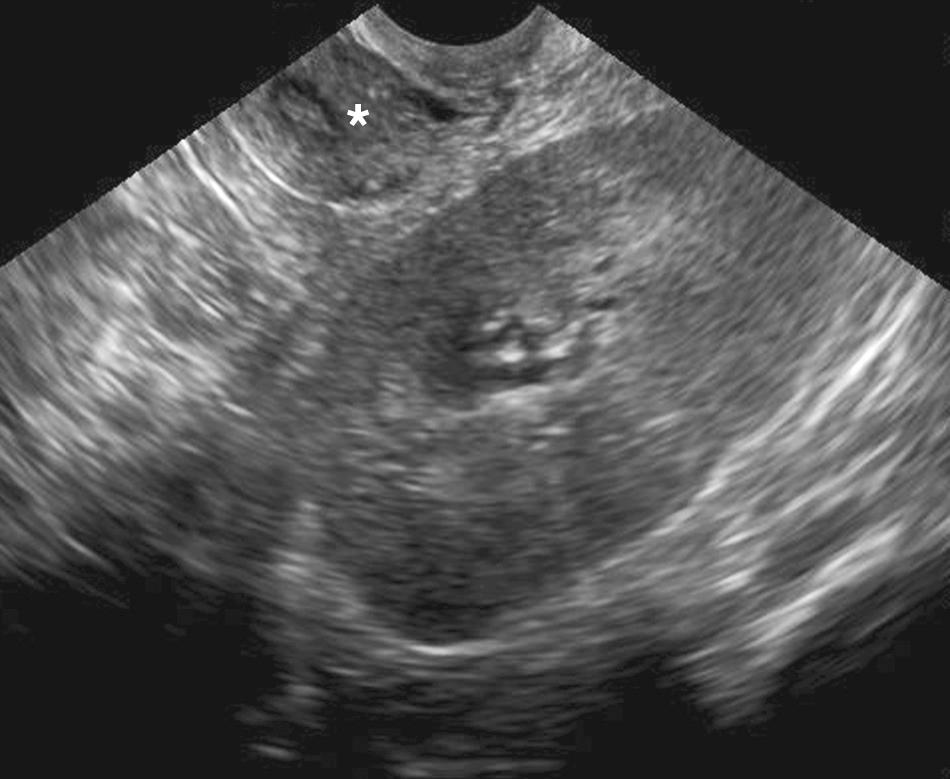
In crossed renal ectopia, both kidneys are found on the same side. In 85% to 90% of cases, the ectopic kidney will be fused to the other kidney (crossed-fused ectopia). The upper pole of the ectopic kidney is usually fused to the lower pole of the other kidney, although fusion may occur anywhere. The incidence is 1 in 1000 to 1 in 1500 at autopsy. Fusion of metanephrogenic blastema does not allow proper rotation or ascent; thus both kidneys are more caudally located, although the ureterovesical junctions (UVJs) are located normally. At sonography, both kidneys are on the same side and are typically fused ( Fig. 9.10 ). In patients with renal colic, knowing that the UVJs are in the normal location is particularly important, since bilateral ureters need to be assessed.
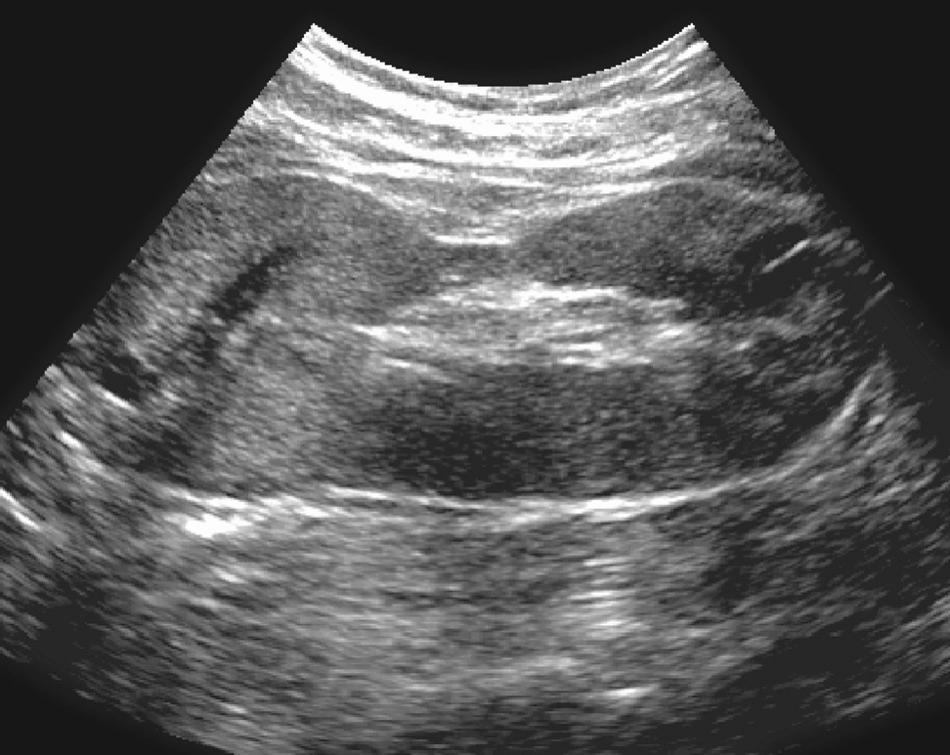
The incidence of horseshoe kidneys in the general population is 0.01% to 0.25%. Horseshoe kidneys occur when metanephrogenic blastema fuse prior to ascent; fusion is usually at the lower poles (95%). Typically, the isthmus is composed of functioning renal tissue, although rarely it is made up of fibrous tissue. The horseshoe kidney sits anterior to the abdominal great vessels and derives its blood supply from the aorta and other regional vessels, such as inferior mesenteric, common iliac, internal iliac, and external iliac arteries. Abnormal rotation of renal pelves often results in ureteropelvic junction (UPJ) obstruction; the horseshoe kidney is thus predisposed to infection and stone formation. Additional associated anomalies include vesicoureteral reflux, collecting system duplication, renal dysplasia, retrocaval ureter, supernumerary kidney, anorectal malformation, esophageal atresia, rectovaginal fistula, omphalocele, and cardiovascular and skeletal abnormalities.
At sonography, horseshoe kidneys are usually lower than normal and the lower poles project medially. Transverse imaging of the retroperitoneum will demonstrate the renal isthmus crossing the midline anterior to abdominal great vessels ( Fig. 9.11 ). Hydronephrosis (pyelocaliectasis) and collecting system calculi may be evident.
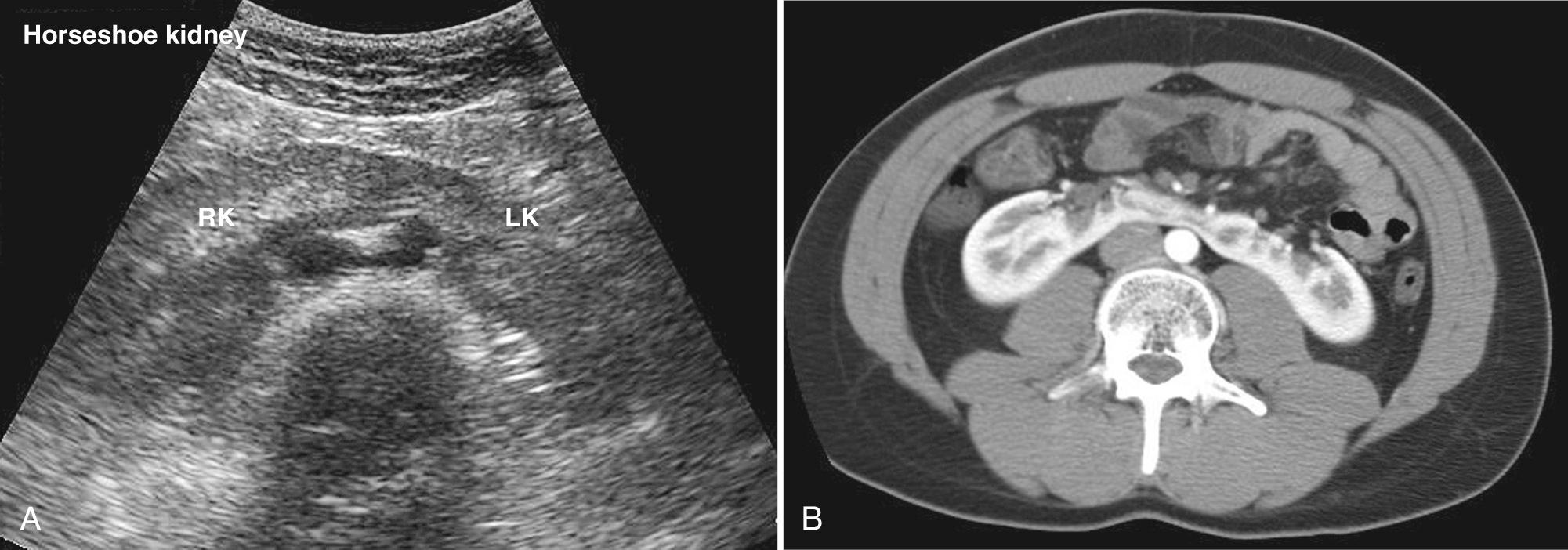
Renal agenesis may be unilateral or bilateral. Bilateral renal agenesis is a rare anomaly that is incompatible with life. The prevalence rate of bilateral agenesis at autopsies is 0.04%. The condition has a 3 : 1 male predominance. Unilateral renal agenesis is usually an incidental finding; the contralateral kidney of these patients may be quite large secondary to compensatory hypertrophy. Renal agenesis occurs when there is (1) absence of the metanephrogenic blastema, (2) absence of ureteral bud development, or (3) absence of interaction and penetration of the ureteral bud with the metanephrogenic blastema. Renal agenesis is associated with genital tract anomalies, which are often cystic pelvic masses in both men and women. Other associated anomalies include skeletal abnormalities, anorectal malformations, and cryptorchidism.
At ultrasound, although the kidney is absent, a normal adrenal gland is usually found. The adrenal gland will be absent in 8% to 17% of patients with renal agenesis. It may be difficult to differentiate between renal agenesis and a small, hypoplastic or dysplastic kidney. With all these conditions, the contralateral kidney will be enlarged as a result of compensatory hypertrophy. Usually, the colon falls into the empty renal bed. Care should be taken not to confuse a loop of gut with a normal kidney.
Supernumerary kidney is an exceedingly rare anomaly. The supernumerary kidney is usually smaller than normal and can be found above, below, in front of, or behind the normal kidney. The supernumerary kidney often has only a few calices and a single infundibulum. The formation of a supernumerary kidney is likely caused by the same mechanism that gives rise to a duplex collecting system. Two ureteric buds reach the metanephrogenic blastema, which then divides, or alternatively, there are initially two blastema. On sonography, an extra kidney will be found.
Duplex collecting system is the most common congenital anomaly of the urinary tract, with an incidence of 0.5% to 10% of live births. The degree of duplication is variable. Duplication is complete when there are two separate collecting systems and two separate ureters, each with their own ureteral orifice. Duplication is incomplete when the ureters join and enter the bladder through a single ureteral orifice. Ureteropelvic duplication arises when two ureteral buds form and join with the metanephrogenic blastema or when there is division of a single ureteral bud early in embryogenesis. Normally during embryologic development, the ureteral orifice migrates superiorly and laterally to become part of the bladder trigone. With complete duplication, the ureter from the lower pole of the kidney migrates to assume its normal location, whereas the ureter draining the superior pole of the kidney migrates abnormally to a more medial and inferior ureteral orifice. Patients have an increased incidence of UPJ obstruction and uterus didelphys.
In complete duplication, the ureter draining the lower pole has a more perpendicular course through the bladder wall, making it more prone to reflux. The ectopic ureter from the upper pole is prone to obstruction, reflux, or both ( Fig. 9.12 ). Obstruction can result in cystic dilatation of the intramural portion of the ureter, giving rise to a ureterocele. Ureteroceles may be unilateral or bilateral and may occur in normal, duplicated, or ectopic ureters. Ureteroceles may result in ureteral obstruction and give rise to recurrent or persistent UTIs. If large, they may block the contralateral ureteral orifice and the urethral orifice at the bladder neck. Treatment of these symptomatic ureteroceles is surgical. However, most ureteroceles are transient, incidental, and clinically insignificant.
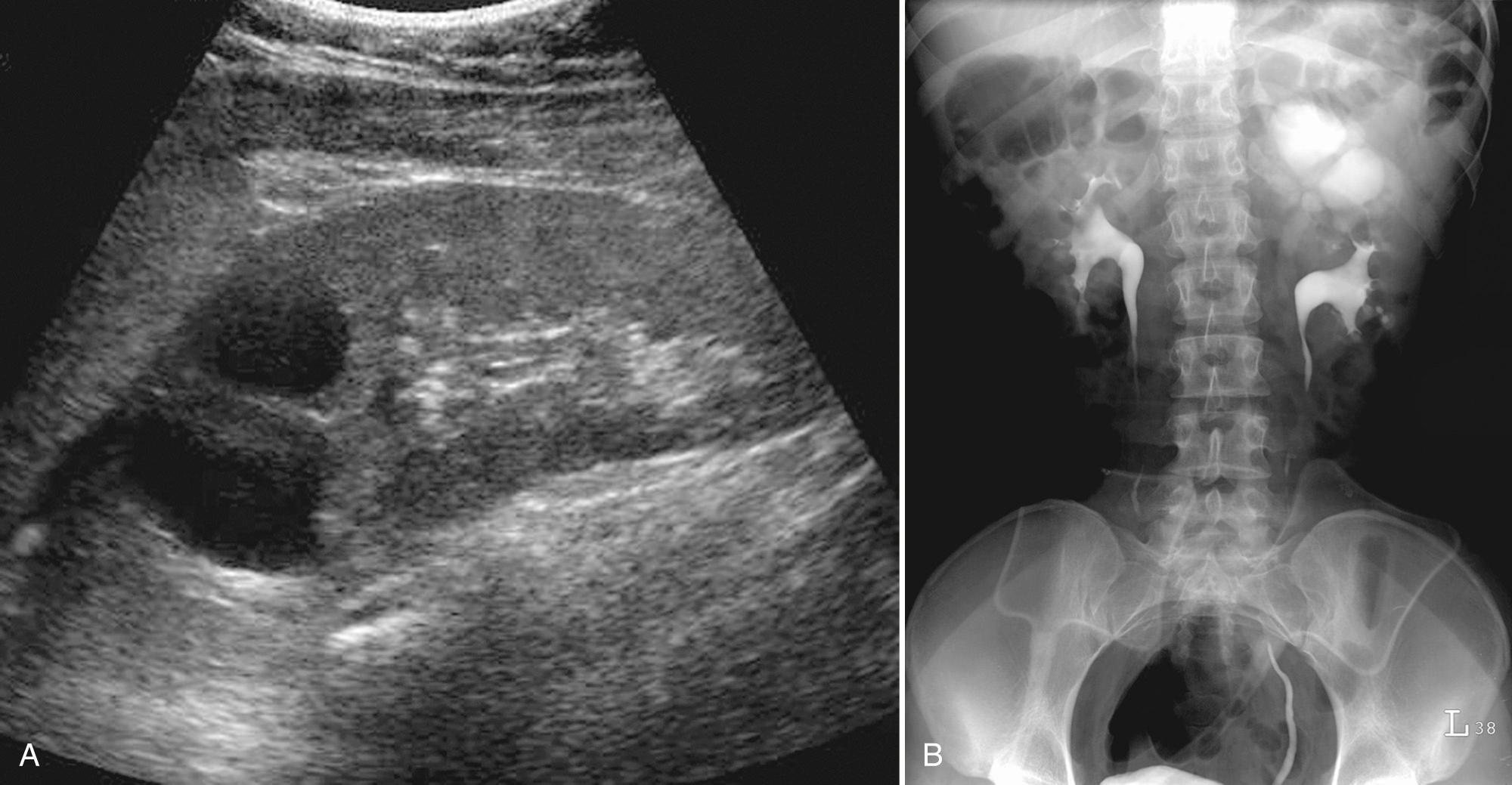
At ultrasound, a duplex collecting system is seen as two central echogenic renal sinuses with intervening, bridging renal parenchyma. Unfortunately, this sign is insensitive and is only seen in 17% of duplex kidneys. Hydronephrosis of the upper-pole moiety and visualization of two distinct collecting systems and ureters are diagnostic. The bladder should always be carefully evaluated for the presence of a ureterocele. A ureterocele will appear as a round, cystlike structure within the bladder ( Fig. 9.13 ). Occasionally, it may be large enough to occupy the entire bladder and will cause obstruction of the bladder neck. In female patients, transvaginal sonography can be helpful to identify small ureteroceles ( Fig. 9.14 ). These ureteroceles may be transient. Madeb et al. demonstrated that transvaginal sonography with color Doppler and spectral analysis can provide additional information about flow dynamics, eliminating the need for invasive procedures.
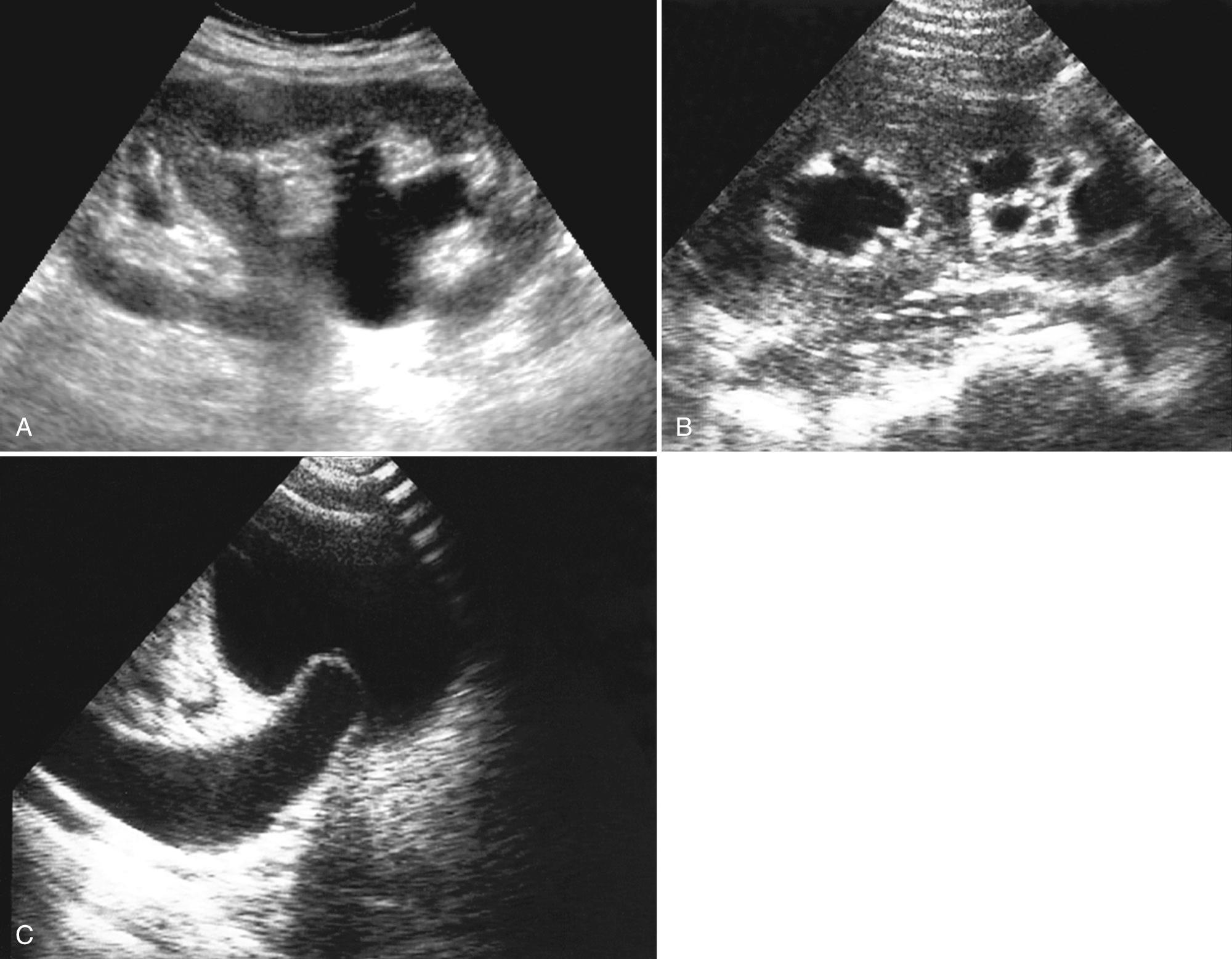
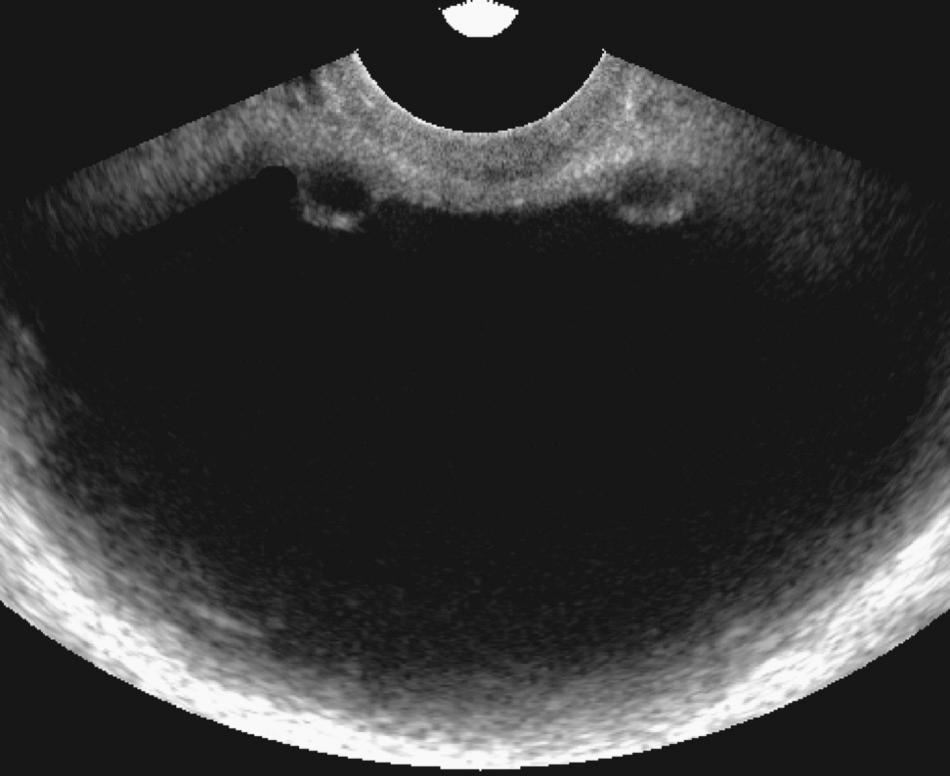
UPJ obstruction is a common anomaly with a 2 : 1 male predominance. The left kidney is affected twice as frequently as the right kidney. UPJ obstruction is bilateral in 10% to 30% of cases. Most adult patients present with chronic, vague, back or flank pain. Symptomatic patients and those with complications, including superimposed infection, stones, or impaired renal function, should be treated. Patients have an increased incidence of contralateral multicystic dysplastic kidney and renal agenesis. Most idiopathic UPJ obstructions are thought to be functional rather than anatomic. Histologic evaluation of affected specimens has demonstrated excessive collagen between muscle bundles, deficient or absent muscle, and excessive longitudinal muscle. Occasionally, intrinsic valves, true luminal stenosis, and aberrant arteries are the cause of obstruction. At ultrasound, hydronephrosis is present to the level of the UPJ ( Fig. 9.15 ). Marked ballooning of the renal pelvis is often shown, and if long-standing, there will be associated renal parenchymal atrophy. The caliber of the ureter, on the other hand, is normal. Careful evaluation of the contralateral kidney should be performed to exclude associated anomalies.
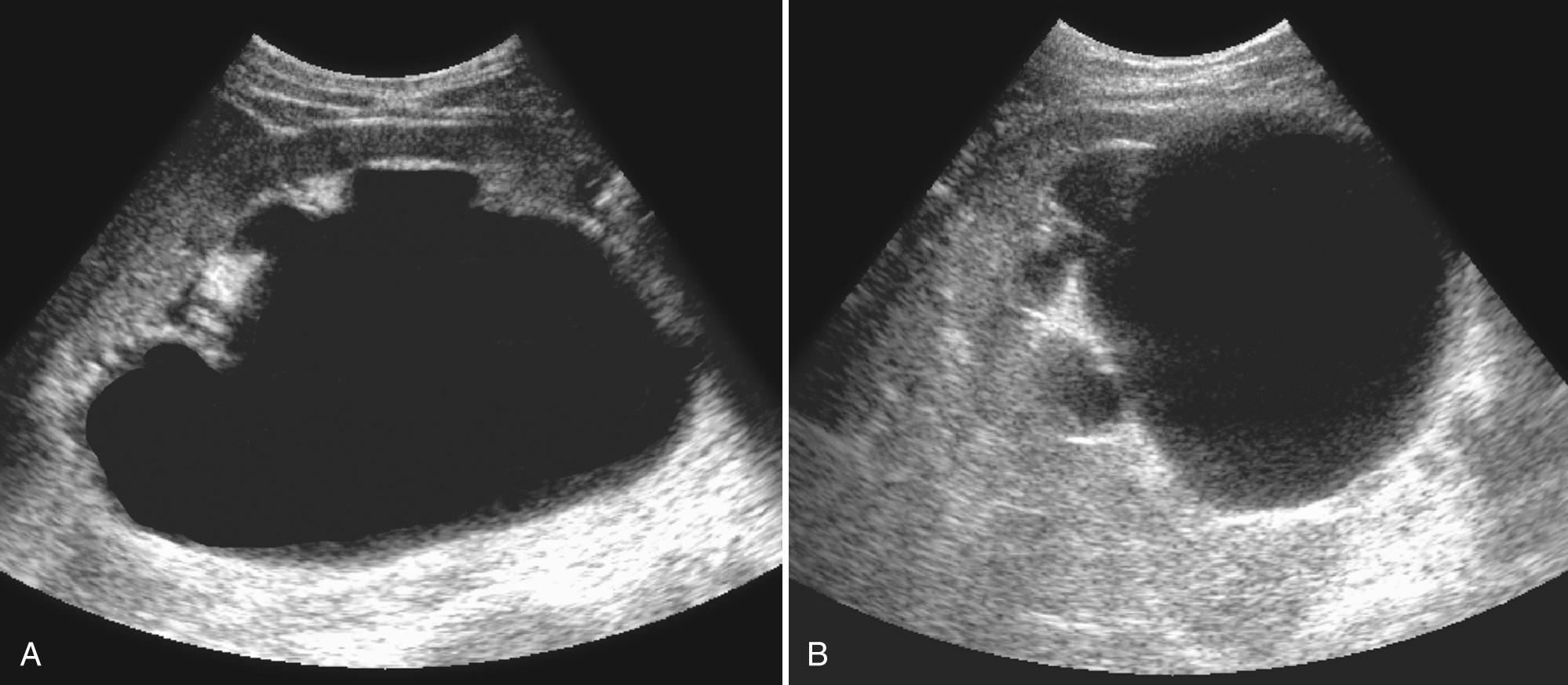
Congenital megacalices refer to typically unilateral, nonobstructive enlargement of the calices. It is nonprogressive; overlying parenchyma and renal function are maintained. Infection and stone formation are increased because of caliceal enlargement. The exact pathogenesis is speculative; the most common association is with primary megaureter. At ultrasound, numerous enlarged clubbed calices are shown. Papillary impressions are absent, and cortical thickness is maintained.
Megaureter (congenital megaureter, megaloureter) results in functional ureteric obstruction. The most distal segment of ureter is aperistaltic: focal ureteral lack of peristalsis results in a wide spectrum of findings, from insignificant distal ureterectasis to progressive hydronephrosis/hydroureter. As with UPJ obstructions, men are affected more often, and the left ureter is typically involved. Bilateral involvement has been demonstrated in 8% to 50% of patients. The classic finding at ultrasound is fusiform dilatation of the distal third of the ureter ( Fig. 9.16 ). Depending on the severity, associated pyelocaliectasis may or may not be present. Calculi may form just proximal to the adynamic segment.
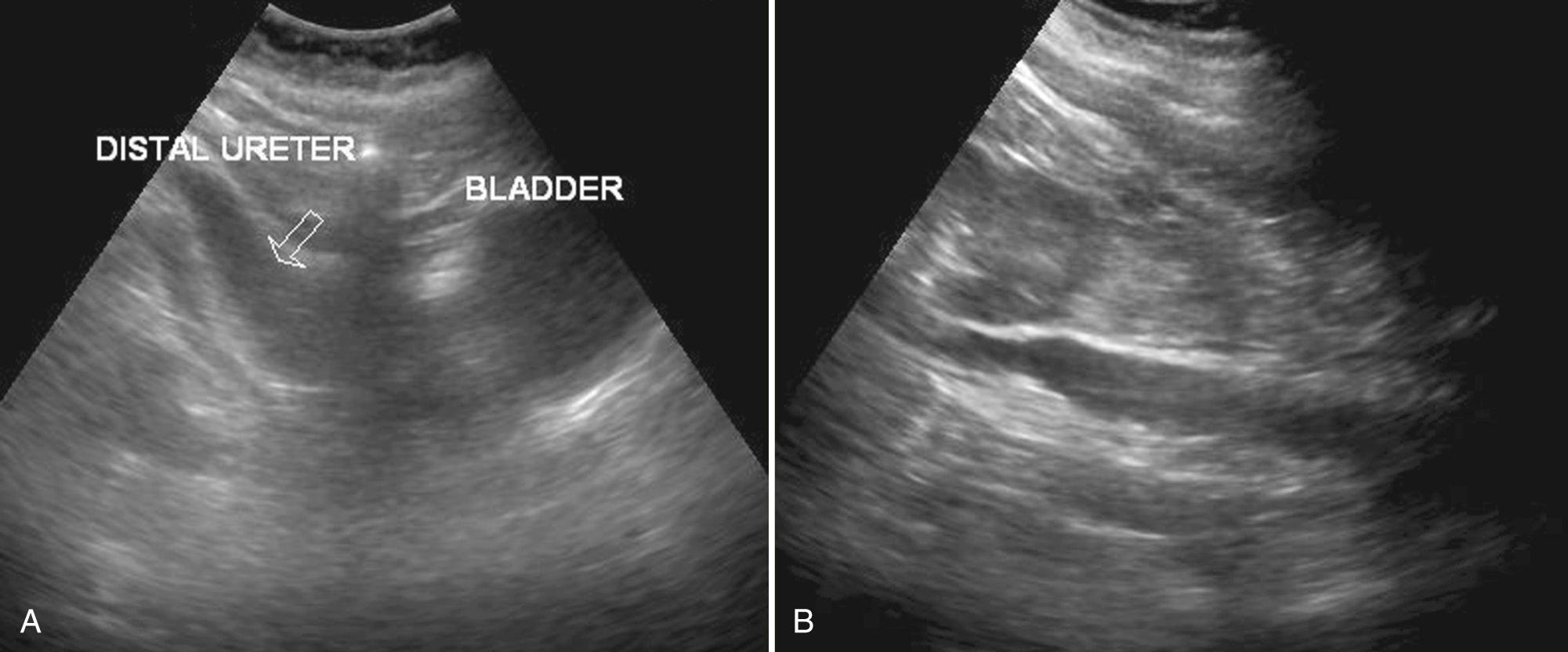
As it ascends during embryologic development, the kidney derives its blood supply from successively higher levels of the aorta. Aberrant renal arteries will be present if the vascular supply from the lower levels of the aorta persists. Aberrant vessels can compress the ureter anywhere along its course. Color Doppler ultrasound may be useful to identify obstructing vessels crossing at the UPJ.
Retrocaval ureter is a rare but well-recognized congenital anomaly with a 3 : 1 male predominance. Most patients present with pain in the second to fourth decade of life. Normally, the infrarenal inferior vena cava (IVC) develops from the supracardinal vein; if it develops from the subcardinal vein, the ureter will pass posterior to the IVC. The ureter then passes medially and anteriorly between the aorta and IVC to cross the right iliac vessels. It then enters the pelvis and bladder in a normal manner. Sonography shows collecting system and proximal ureteral dilatation. In easy-to-scan patients the compressed retrocaval ureter may be identified.
Bladder agenesis is a rare anomaly. Most infants with bladder agenesis are stillborn; virtually all surviving infants are female. Many associated anomalies are often present. At ultrasound, the bladder is absent.
Bladder duplication is divided into three types, as follows :
Type 1: A complete or incomplete peritoneal fold separates the two bladders.
Type 2: An internal septum divides the bladder. The septum may be complete or incomplete and may be oriented in a sagittal or coronal plane. There may be multiple septa.
Type 3: A transverse band of muscle divides the bladder into two unequal cavities.
Bladder exstrophy occurs in 1 in 30,000 live births, with a 2 : 1 male predominance. Failure in development of the mesoderm below the umbilicus leads to absence of the lower abdominal and anterior bladder wall. There is a high incidence of associated musculoskeletal, gastrointestinal, and genital tract anomalies. These patients have an increased (200-fold) incidence of bladder carcinoma (adenocarcinoma in 90%).
Normally, the urachus closes in the last half of fetal life. The four types of congenital urachal anomalies, in order of frequency, are as follows ( Fig. 9.17 ):
Patent urachus (50%)
Urachal cyst (30%)
Urachal sinus (15%)
Urachal diverticulum (5%)
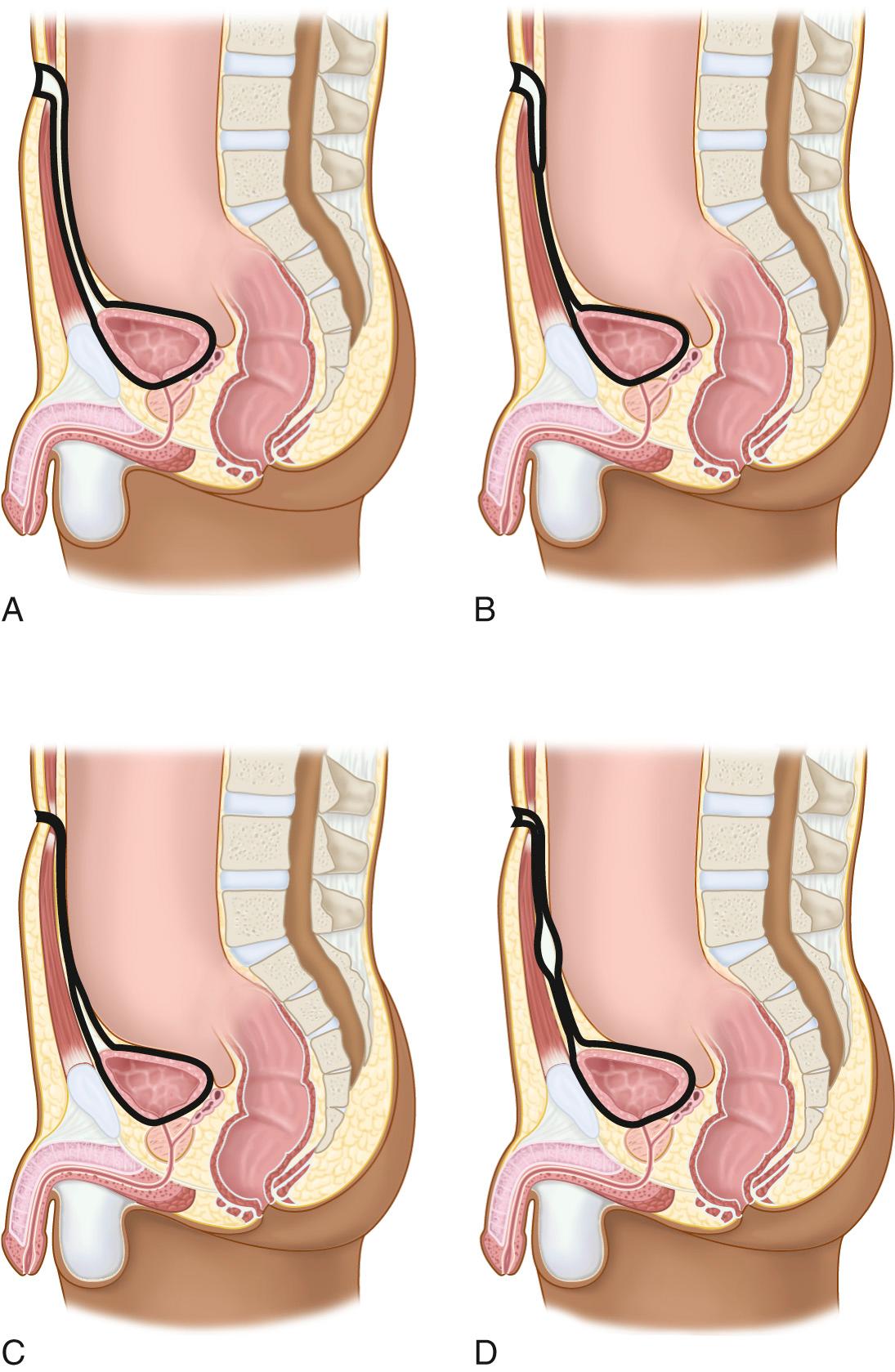
Urachal anomalies have a 2 : 1 predominance in males. A patent urachus is usually associated with urethral obstruction and serves as a protective mechanism to allow normal fetal development. A urachal cyst forms if the urachus closes at the umbilical and bladder ends but remains patent in between. The cyst is usually situated in the lower third of the urachus. There is an increased incidence of adenocarcinoma. At ultrasound, a midline cyst with or without internal echoes is seen superior to the bladder. A urachal sinus forms when the urachus closes at the bladder end but remains patent at the umbilicus. A urachal diverticulum forms if the urachus closes at the umbilical end but remains patent at the bladder. Urachal diverticula are usually incidentally found. There is an increased incidence of carcinoma and stone formation.
The majority of urethral diverticula are acquired secondary to injury or infection, although congenital diverticula occur rarely. Most urethral diverticula in women form as a result of infection of the periurethral glands; some may be related to childbirth. Most diverticula are found in the midurethra and are bilateral. Often, a fluctuant anterior vaginal mass is felt. Stones may develop because of urinary stasis. Transvaginal or translabial scanning may demonstrate a simple or complex cystic structure communicating with the urethra through a thin neck ( Fig. 9.18 ).
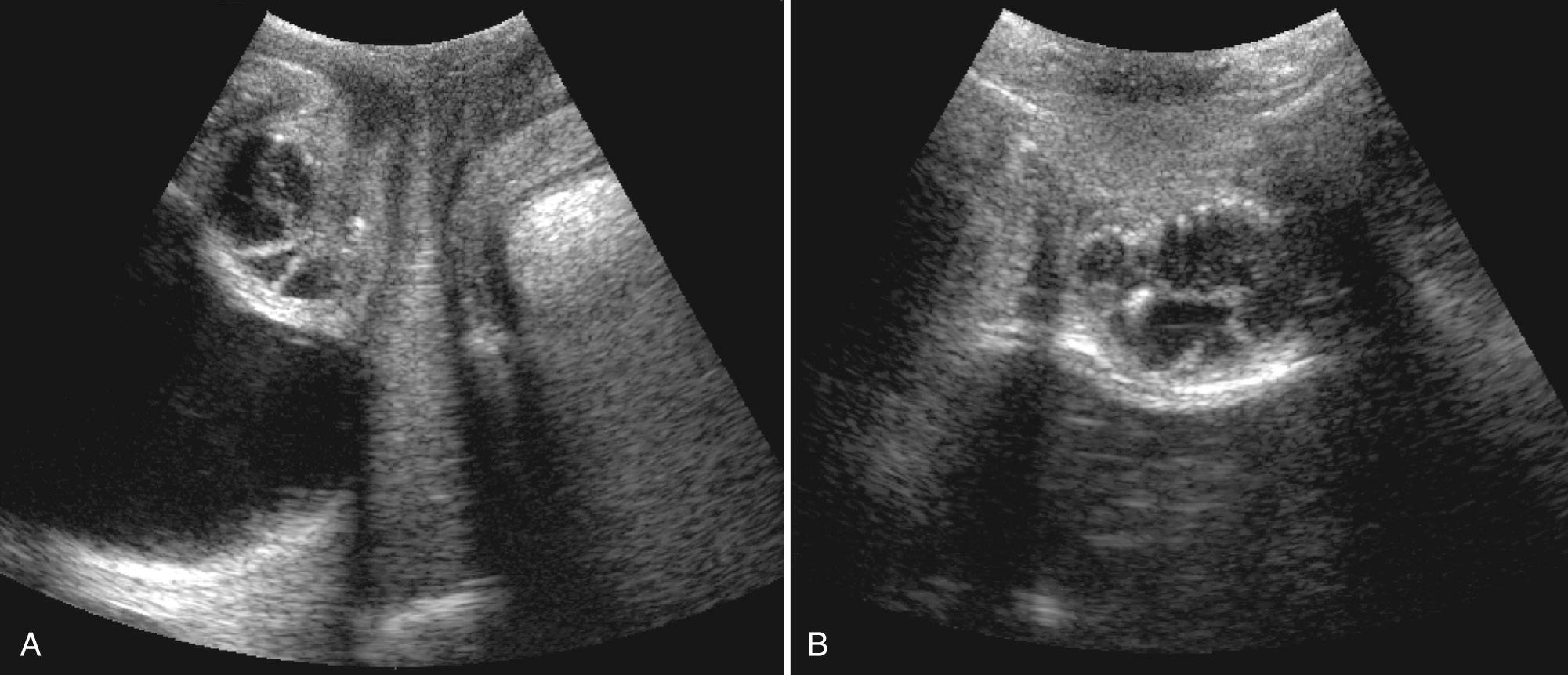
Acute pyelonephritis is a tubulointerstitial inflammation of the kidney. Two routes may lead to inflammation: ascending infection (85%; e.g., Escherichia coli ) and hematogenous seeding (15%; e.g., Staphylococcus aureus ). Women age 15 to 35 years are most often affected ; 2% of pregnant women will develop acute pyelonephritis. Most adults present with flank pain and fever and can be diagnosed clinically with the aid of laboratory studies (bacteriuria, pyuria, and leukocytosis). With appropriate antibiotics, both clinical and laboratory findings show rapid improvement. Imaging is necessary only when symptoms and laboratory abnormalities persist: imaging is useful to identify potential causes of insufficiently treated infection, including renal and perirenal abscesses, calculi, and urinary obstruction. The Society of Uroradiology proposed using acute pyelonephritis to describe acutely infected kidneys, eliminating the need for terms such as bacterial nephritis, lobar nephronia, renal cellulitis, lobar nephritis, renal phlegmon, and renal carbuncle.
At ultrasound, the majority of kidneys with acute pyelonephritis appear normal. However, ultrasound findings of pyelonephritis include ( Fig. 9.19 ) renal enlargement, compression of the renal sinus, decreased echogenicity (secondary to edema) or increased echogenicity (potentially from hemorrhage), loss of corticomedullary differentiation, poorly marginated mass(es), gas within the renal parenchyma, and focal or diffuse absence of color Doppler perfusion corresponding to the swollen inflamed areas.
Renal enlargement
Compression of renal sinus
Abnormal echogenicity (either increased or decreased)
Loss of corticomedullary differentiation
Poorly marginated mass(es)
Gas within renal parenchyma
Focal or diffuse absence of color Doppler perfusion corresponding to the swollen inflamed areas
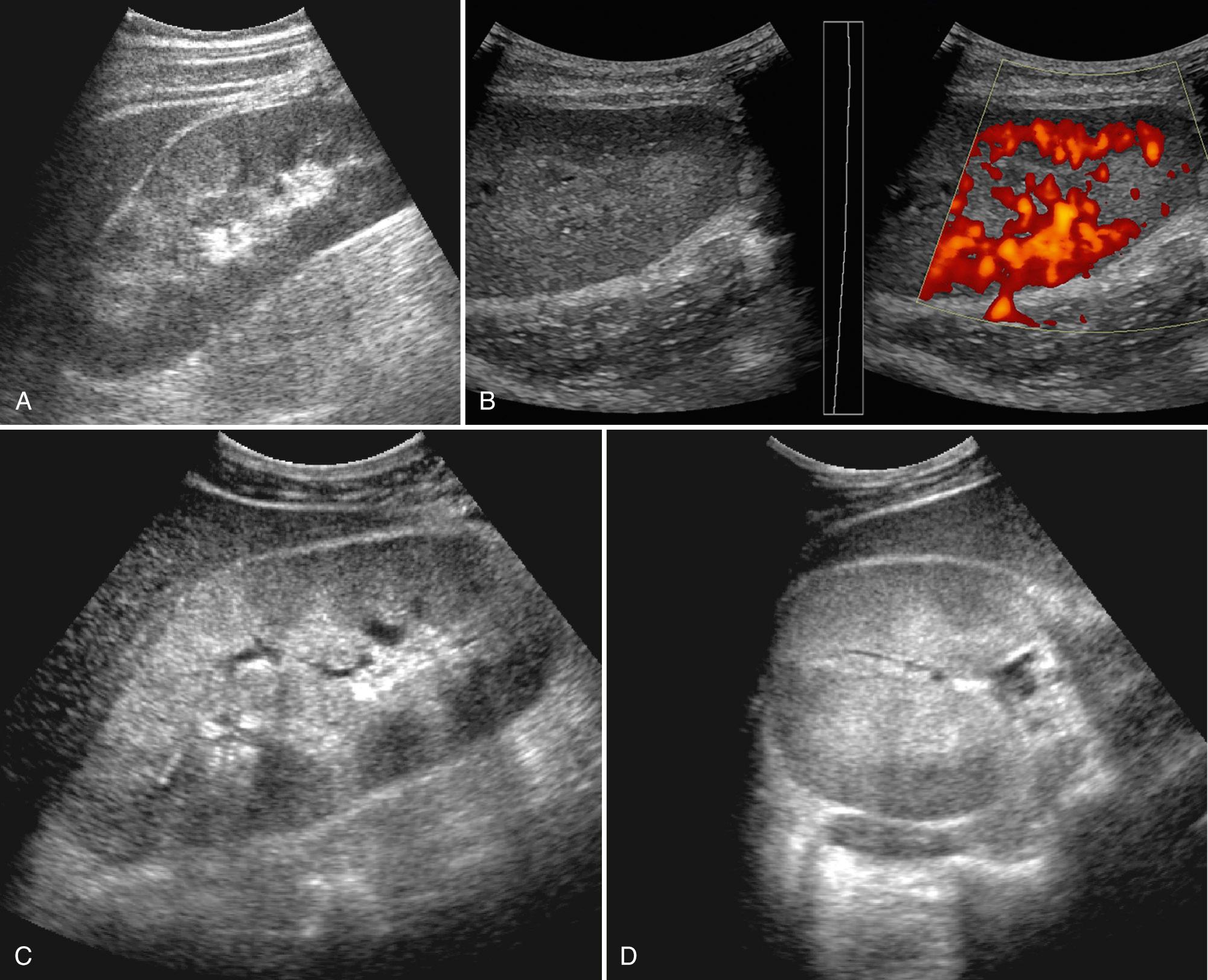
If the pyelonephritis is focal, the poorly marginated masses may be echogenic, hypoechoic, or of mixed echogenicity. Echogenic masses may be the most common appearance of focal pyelonephritis.
Sonography, including power Doppler, is less sensitive than CT, magnetic resonance imaging (MRI), or technetium-99m single-photon emission computed tomography ( 99m Tc-DMSA SPECT) renal cortical scintigraphy for demonstrating changes of acute pyelonephritis. However, ultrasound is more accessible and less expensive and thus an excellent screening modality for monitoring and follow-up of complications, as well as in the assessment of pregnant patients with acute pyelonephritis because of its lack of ionizing radiation.
A unique renal infection known as alkaline-encrusted pyelitis has been described in renal transplants and native kidneys of debilitated and immunocompromised patients. This entity is most frequently caused by Corynebacterium urealyticum, a urea-splitting microorganism. Urothelial stone encrustation develops in the kidney and bladder. If the kidney is affected, the patient may present with hematuria, stone passage, or an ammonium odor to the urine. Dysuria and suprapubic pain are the most common clinical signs if the bladder is involved. Treatment is with antibiotics and local acidification of the urine. On sonography, alkaline-encrusted pyelitis is suggested if thickened, calcified urothelium is identified. The calcification can be thin and smooth or thick and irregular. Care should be taken to distinguish urothelial calcification from layering of collecting system calculi.
Untreated or inadequately treated acute pyelonephritis may lead to parenchymal necrosis and abscess formation. Patients at increased risk for renal abscesses include those with diabetes, compromised immunity, chronic debilitating diseases, urinary tract obstruction, infected renal calculi, and intravenous drug abuse. Renal abscesses tend to be solitary and may spontaneously decompress into the collecting system or perinephric space. Perinephric abscesses, also a complication of pyonephrosis, may result from direct extension of peritoneal or retroperitoneal infection or interventions. Small abscesses are treated conservatively with antibiotics, whereas larger abscesses often require percutaneous drainage and, if drainage is unsuccessful, surgery.
At ultrasound, renal abscesses appear as round, thick-walled, hypoechoic complex masses with through transmission ( Fig. 9.20 ). Internal mobile debris and septations may be seen. Occasionally, “dirty shadowing” may be noted posterior to gas within the abscess. The differential diagnosis includes (1) hemorrhagic or infected cysts, (2) parasitic cysts, (3) multiloculated cysts, and (4) cystic neoplasms. Although not as accurate as CT in determining the presence and extent of perinephric abscess extension, sonography is an excellent modality for following conservatively treated patients with abscesses to document resolution.
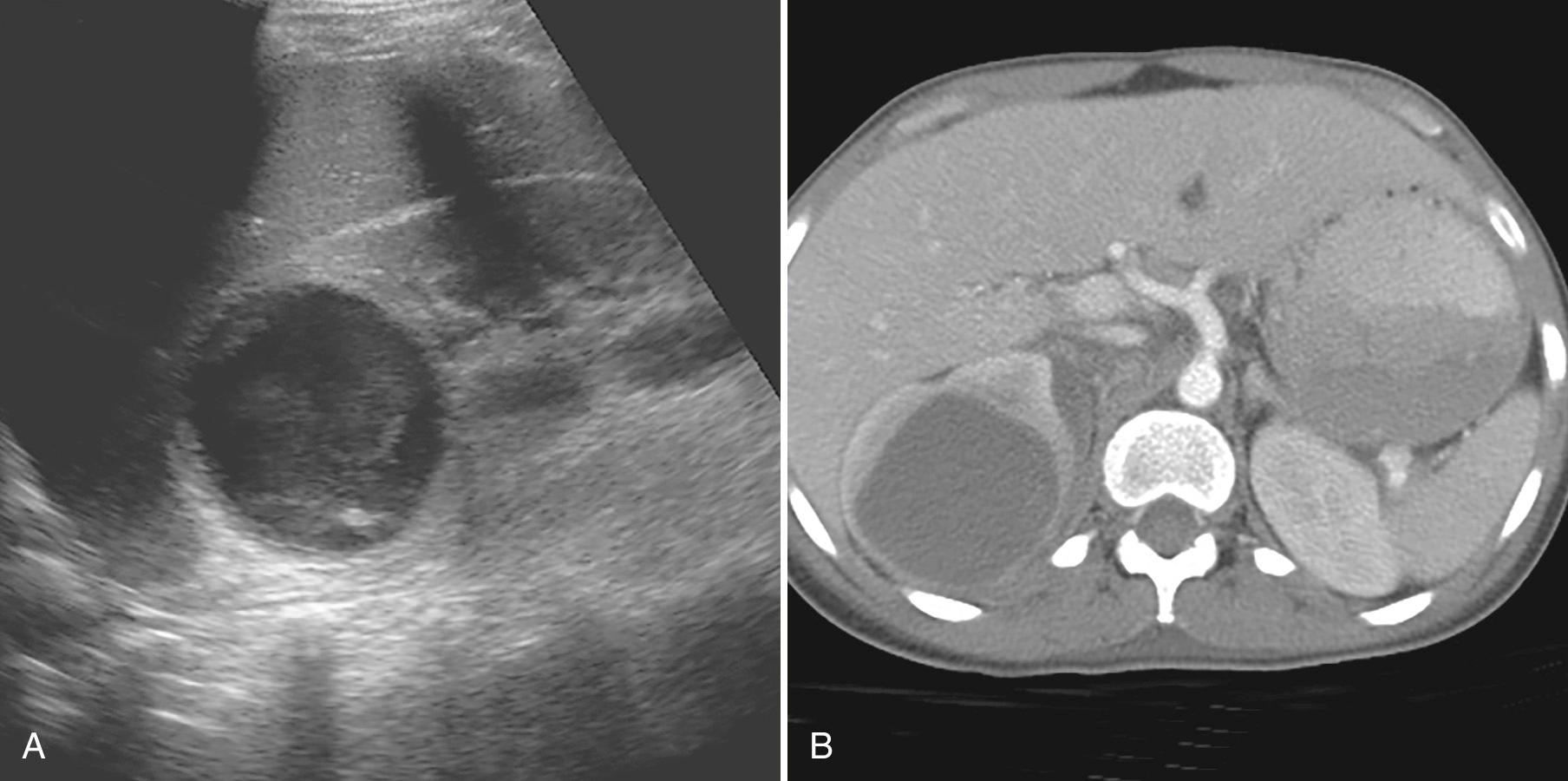
Pyonephrosis implies purulent material in an obstructed collecting system. Depending on the level of obstruction, any portion of the collecting system, including the ureter, can be affected. Early diagnosis and treatment are crucial to prevent development of bacteremia and life-threatening septic shock. The mortality rates of bacteremia and septic shock are 25% and 50%, respectively ; 15% of patients are asymptomatic at presentation. In the young adult, UPJ obstruction and calculi are the most frequent cause of pyonephrosis, whereas malignant ureteral obstruction is typically the predisposing factor in older patients. Pyonephrosis is suggested when ultrasound shows mobile collecting system debris (with or without a fluid-debris level), collecting system gas, and stones ( Fig. 9.21 ).
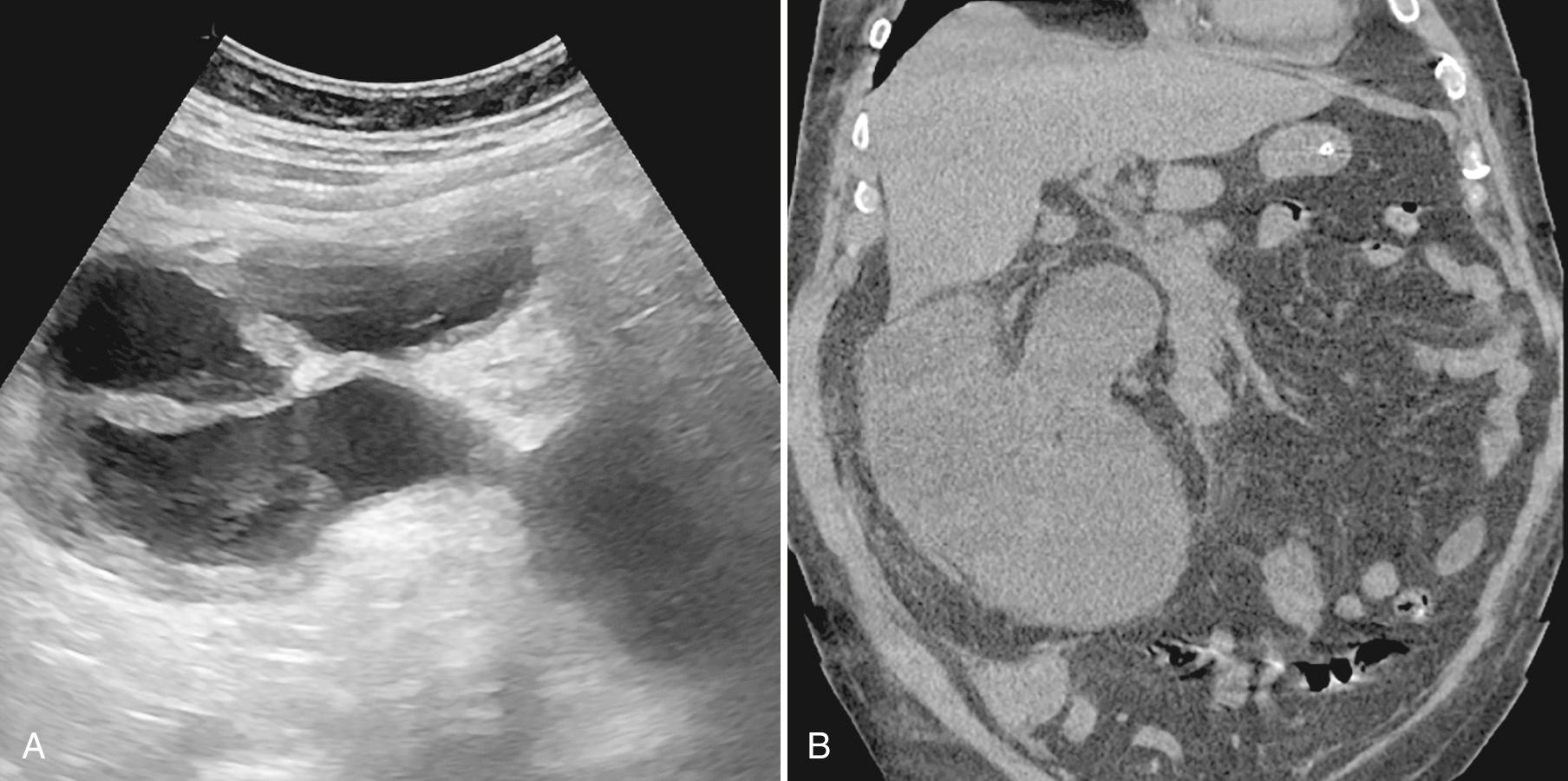
Emphysematous pyelonephritis (EPN) is an uncommon, life-threatening infection of the renal parenchyma characterized by gas formation. Most patients are women (2 : 1) and diabetic (90%), with a mean age of 55 years. In diabetic patients, EPN tends to occur in nonobstructed collecting systems; the reverse is true in nondiabetic patients. Bilateral disease occurs in 5% to 10% of EPN patients. Escherichia coli is the offending organism in 62% to 70% of cases; Klebsiella (9%), Pseudomonas (2%) Proteus, Aerobacter, and Candida are additional causative organisms. At presentation, most patients are extremely ill with fever, flank pain, hyperglycemia, acidosis, dehydration, and electrolyte imbalance ; 18% present only with fever of unknown origin.
Wan et al. retrospectively studied 38 patients with EPN and identified two types of disease: EPN1, characterized by parenchymal destruction and streaky or mottled gas, and EPN2, characterized as renal or perirenal fluid collections, with bubbly or loculated gas or with gas in the collecting system. Mortality rates for EPN1 and EPN2 were 69% and 18%, respectively. The authors postulated that the different clinical outcomes of EPN1 and EPN2 result from the patient's immune status and the vascular supply of the affected kidney. Emergency nephrectomy is the treatment of choice for EPN1, whereas percutaneous drainage is recommended for EPN2. CT is the preferred method to image patients with EPN, to determine the location and extent of renal and perirenal gas. Sonographic evaluation of EPN1 or EPN2 may be difficult because dirty shadowing from parenchymal gas will obscure deeper structures; shadowing might also prompt an erroneous interpretation of renal calculi or bowel gas ( Fig. 9.22 ).
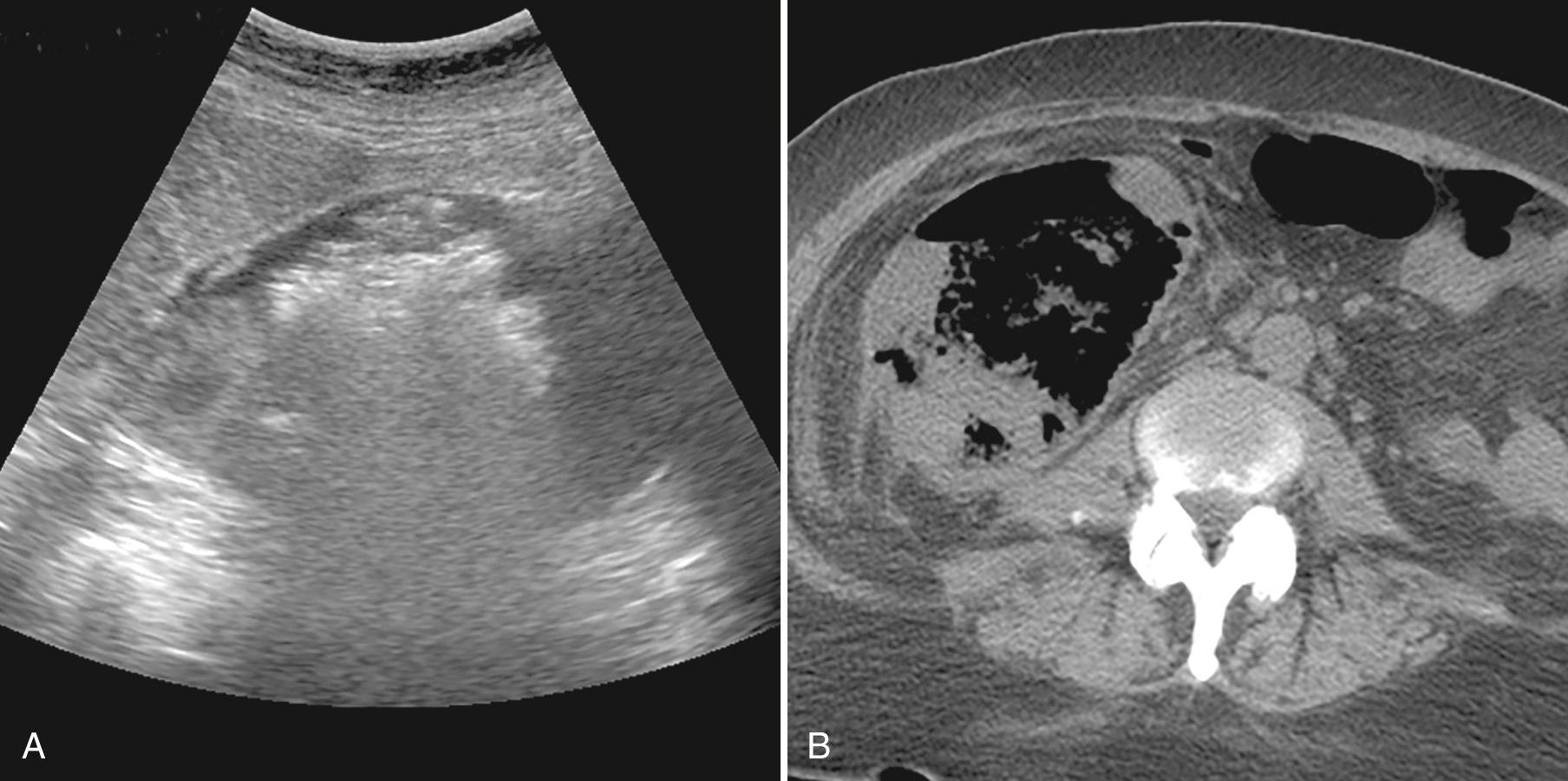
Emphysematous pyelitis refers to gas localized within the urinary collecting system. This disease entity is seen most often in women with diabetes or obstructing stone disease; a mortality rate of 20% has been reported. It is important to exclude iatrogenic causes of gas within the collecting system. At ultrasound, nondependent linear echogenic lines with dirty distal posterior acoustic shadowing, indicative of gas are seen within the collecting system ( Fig. 9.23 ). As with EPN, CT is often required to identify emphysematous pyelitis because dirty acoustic shadowing from gas at ultrasound may obscure the exact extent of renal and perirenal disease.
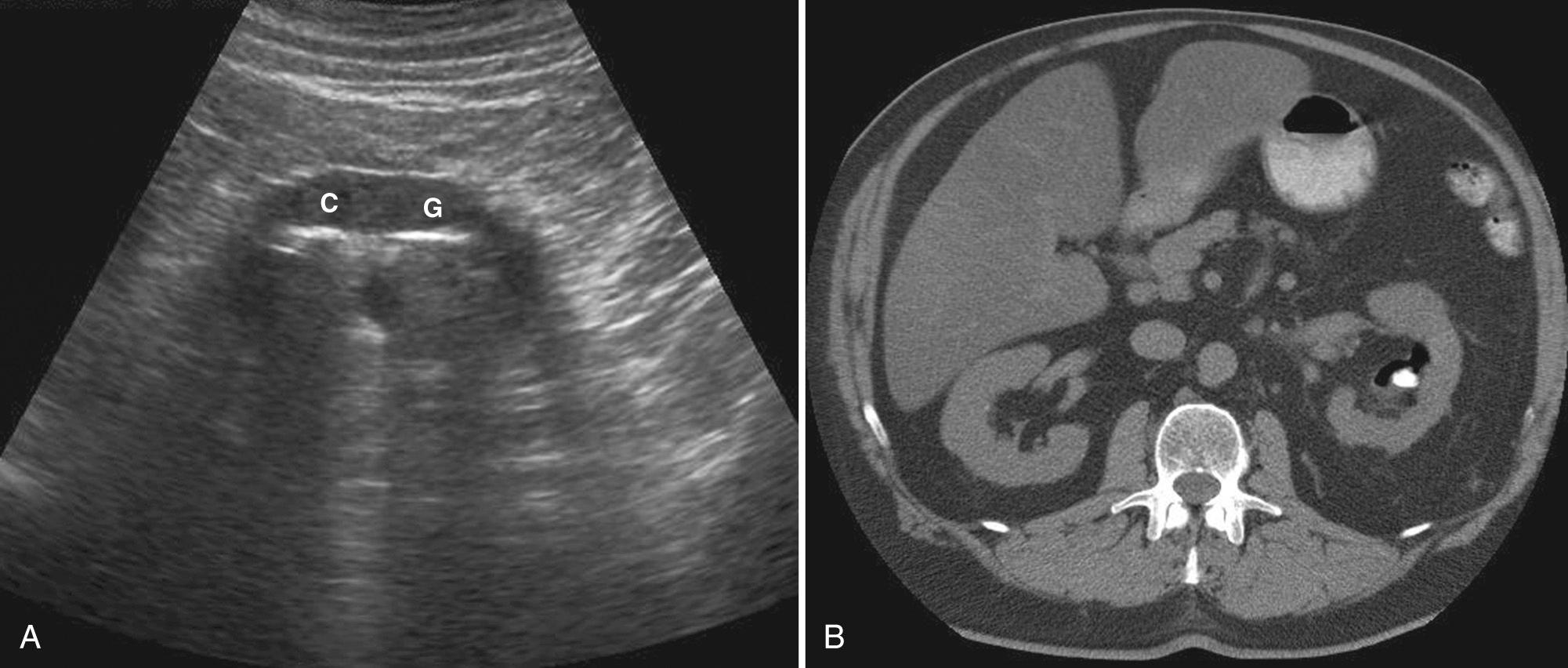
Chronic pyelonephritis is an interstitial nephritis often associated with vesicoureteric reflux. Reflux nephropathy is believed to cause 10% to 30% of all cases of end-stage renal disease (ESRD) ( Fig. 9.24 ). Chronic pyelonephritis usually begins in childhood and is more common in women. The renal changes may be unilateral or bilateral but usually are asymmetric. Reflux into the collecting tubules occurs when the papillary duct orifices are incompetent. This reflux occurs more often in compound papillae, which are typically found at the poles of the kidneys. Cortical scarring therefore tends to occur over polar calices. There is associated papillary retraction with caliceal clubbing. At ultrasound, a dilated blunt calix is seen, associated with overlying cortical scar or cortical atrophy ( Fig. 9.25 ). These changes may be multicentric and bilateral. If the disease is unilateral, there may be compensatory hypertrophy of the contralateral kidney. If the disease is multicentric, compensatory hypertrophy of normal intervening parenchyma may create an island of normal tissue simulating a tumor.
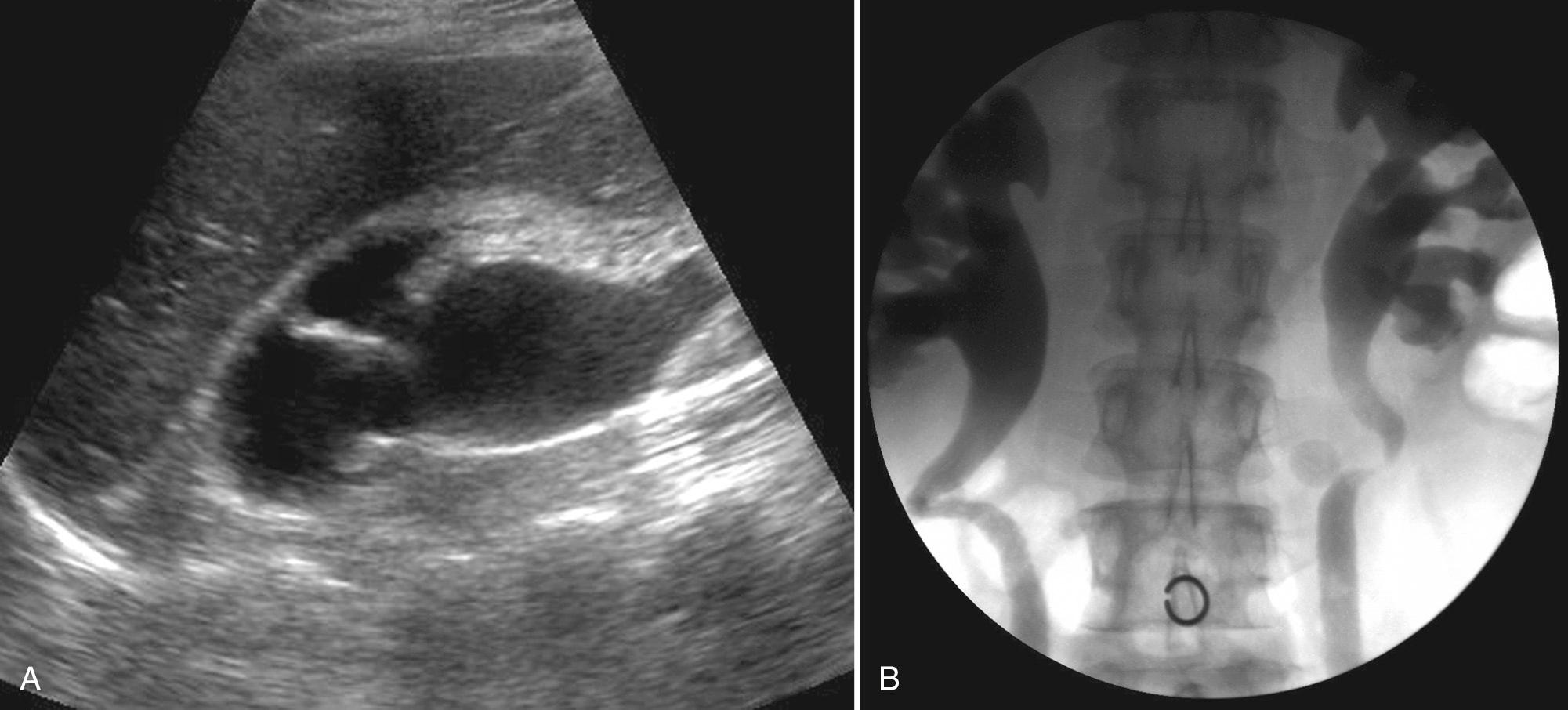
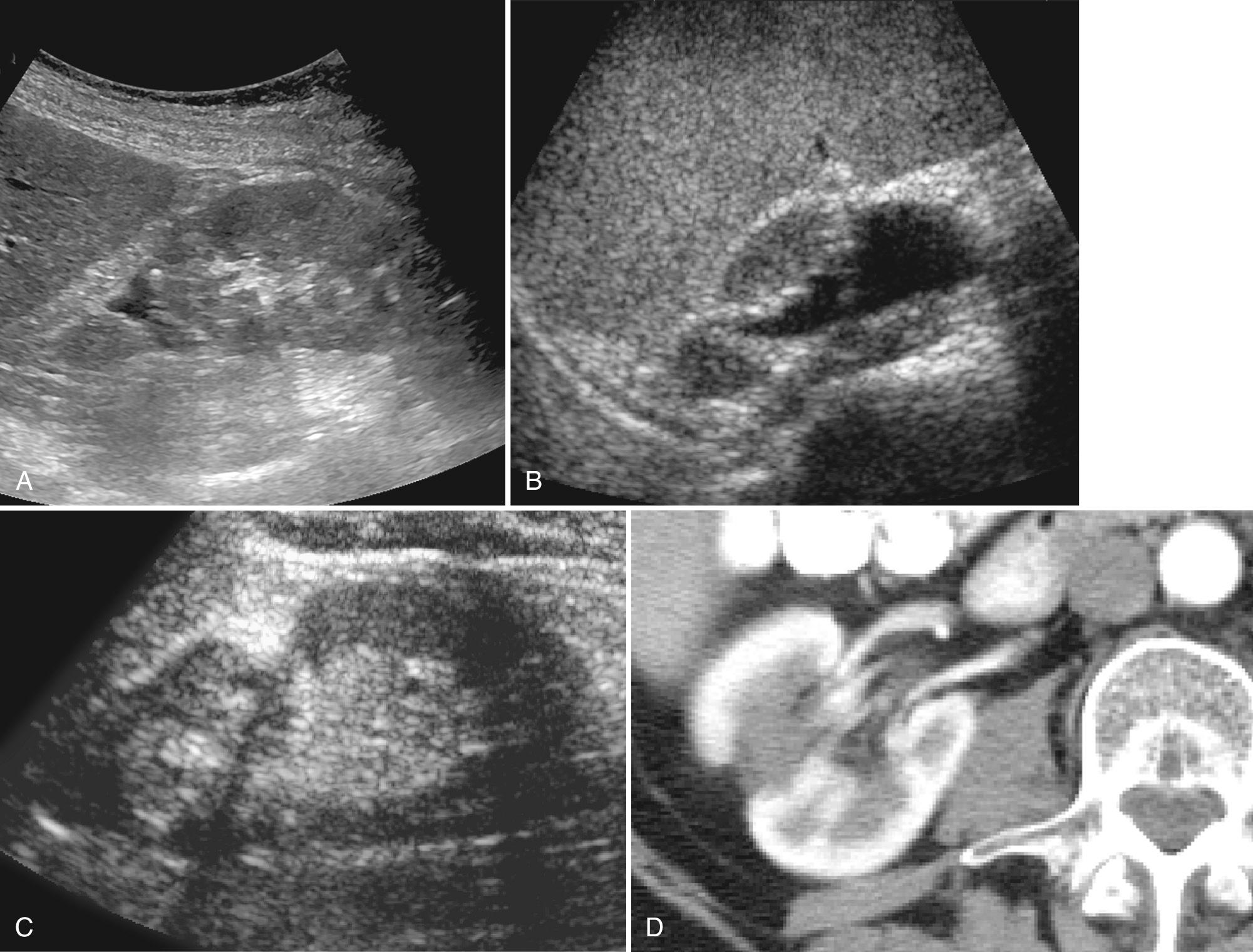
Xanthogranulomatous pyelonephritis (XGP) is a chronic, suppurative renal infection in which destroyed renal parenchyma is replaced with lipid-laden macrophages. XGP is typically unilateral and may be diffuse, segmental, or focal. XGP is typically associated with nephrolithiasis (70%) and obstructive nephropathy. The disease most commonly occurs in middle-aged women and diabetic patients. Presenting signs are nonspecific: pain, mass, weight loss, and UTI ( Proteus or E. coli ). The diffusely involved kidney is usually nonfunctional. Ultrasound findings of diffuse XGP include renal enlargement, maintenance of a reniform shape, and lack of corticomedullary differentiation. Multiple hypoechoic areas correspond to dilated calices or inflammatory parenchymal masses. Through transmission is variable and depends on the degree of liquefaction of the parenchymal masses. Occasionally, the large, complex cystic masses may mimic pyonephrosis. A staghorn calculus will result in extensive shadowing from the central renal sinus ( Fig. 9.26 ). Perinephric extension may occur, but this is often best appreciated with CT. Diffuse XGP has no specific sonographic features but is suggested when parenchymal thinning, hydronephrosis, stones, debris in a dilated collecting system, and perinephric fluid collections are present. Segmental XGP will be seen as one or more hypoechoic masses, often associated with a single calyx. An obstructing calculus may be seen near the papilla. Focal XGP arises in the renal cortex and does not communicate with the renal pelvis. It cannot be distinguished sonographically from tumor or abscess.
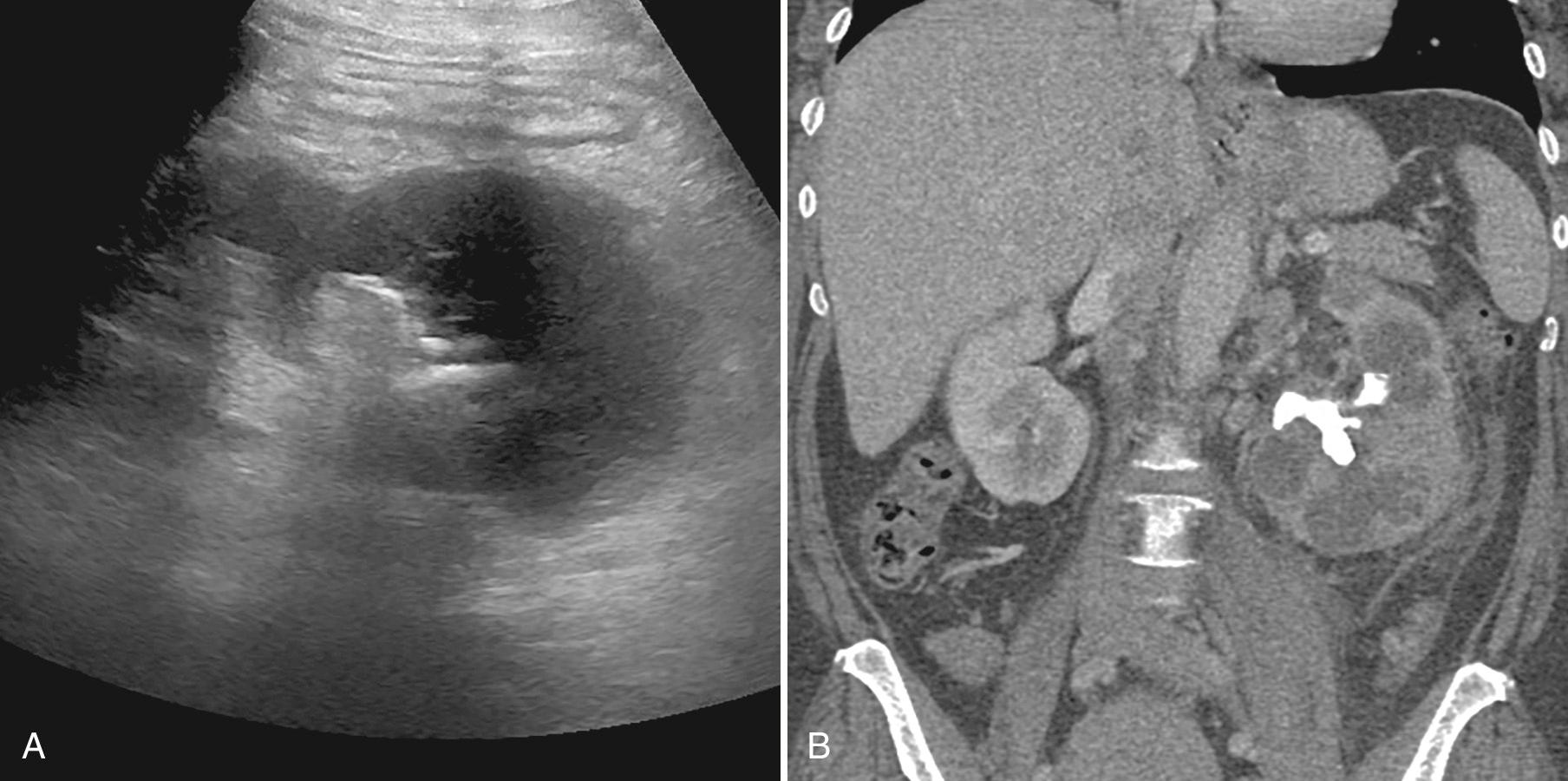
Causative factors implicated in the ischemia that leads to papillary necrosis include analgesic abuse, diabetes, UTI, renal vein thrombosis, prolonged hypotension, urinary tract obstruction, dehydration, sickle cell anemia, and hemophilia. Initially, the papilla swells ( Fig. 9.27 ); then a communication with the caliceal system occurs. The central aspect of the papilla cavitates and may slough. With papillary cavitation, ultrasound shows cystic collections within the medullary pyramids. If the papilla sloughs, the affected adjacent calyx will be clubbed. The sloughed papilla can be seen in the collecting system as an echogenic nonshadowing structure. If the sloughed papilla calcifies, distal acoustic shadowing simulating medullary nephrocalcinosis will be seen. Hydronephrosis may develop if the sloughed papilla obstructs the ureter.
Swollen pyramids
Papillary cavitation
Adjacent clubbed calix
Sloughed papilla in collecting system that can calcify and simulate a stone
Sloughed papilla may cause obstruction
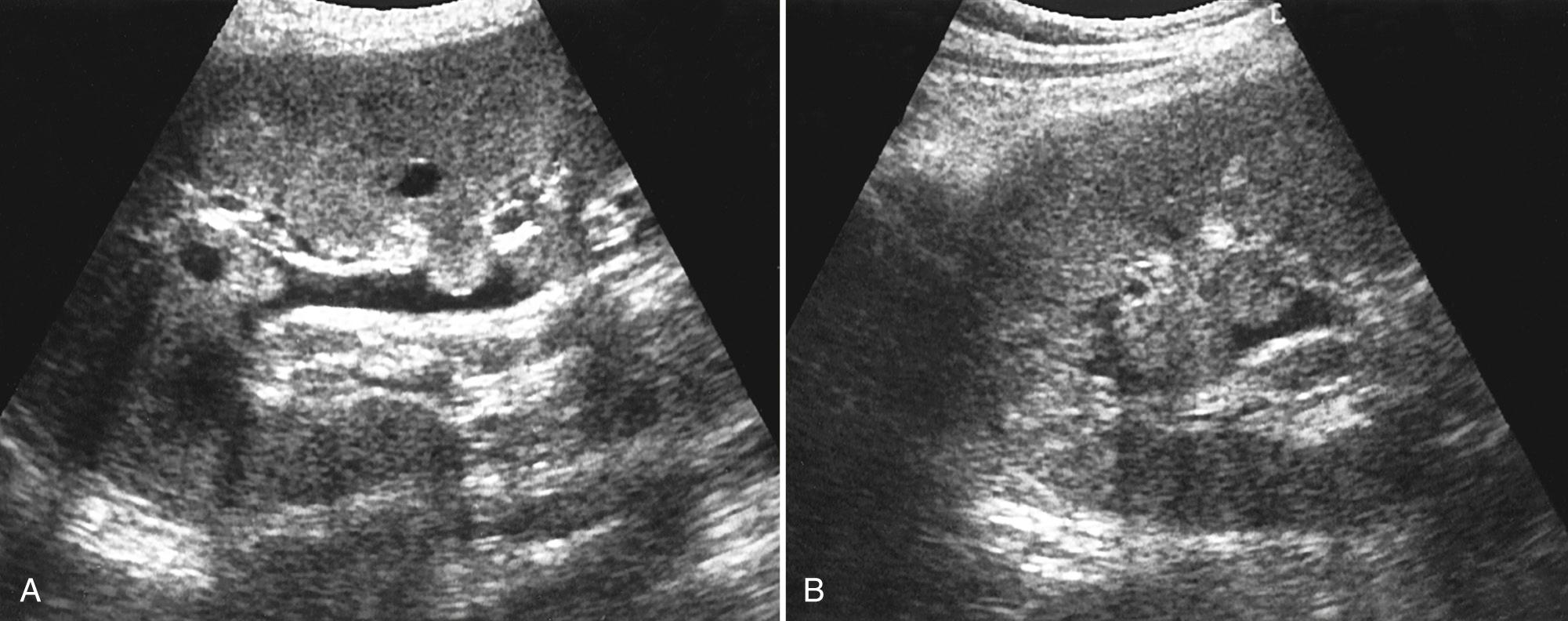
Urinary tract tuberculosis (TB) occurs with hematogenous seeding of the kidney by Mycobacterium tuberculosis from an extraurinary source (typically lung). Urinary tract TB usually manifests 5 to 10 years after the initial pulmonary infection. Chest radiographs may be normal (35%-50% of patients) or may show active TB (10%) or inactive healed TB (40%-55%). Most patients present with lower urinary tract signs and symptoms that include frequency, dysuria, nocturia, urgency, and gross or microscopic hematuria, whereas 10% to 20% of patients are asymptomatic. Urinalysis findings include sterile pyuria, microscopic hematuria, and acidic pH. TB is definitively diagnosed with acid-fast bacilli urine cultures; however, this usually requires 6 to 8 weeks for growth.
Although both kidneys are seeded initially, clinical manifestations of urinary tract TB are typically unilateral. The early or acute changes include development of multiple small bilateral tuberculomas. Das et al. found that the most frequently encountered sonographic abnormality was focal renal lesions ( Fig. 9.28 ). Small focal lesions (5-15 mm) were echogenic or were hypoechoic with an echogenic rim. Larger, mixed-echogenicity focal lesions (>15 mm) were poorly defined. Bilateral disease was noted in 30% of patients. Most tuberculomas will heal spontaneously or after antituberculous therapy. At some later date (perhaps years later), one or more of the tubercles may enlarge. With enlargement, cavitation and communication with the collecting system will occur. The resultant pathologic changes resemble papillary necrosis; papillary involvement is noted when a sonolucent linear tract is shown extending from the involved calix into the papilla. Soft tissue caliceal masses representing sloughed papilla may be seen. After rupture into the collecting system, M. tuberculosis bacilluria develops and allows the spread of the renal infection to other parts of the urinary tract. Spasm or edema in the region of the UVJ may occur, giving rise to hydronephrosis and hydroureter. Ureteric linear ulcers may also occur, typically within the distal ureter. Bladder involvement is seen in 33% of patients with genitourinary tract TB. Early bladder manifestations include mucosal edema and ulceration. Early clinical symptoms (dysuria and frequency) are also nonspecific. If edema occurs at the bladder trigone, ureteric obstruction may occur. At ultrasound, early bladder involvement will appear as focal or diffuse wall thickening; the thickening can be quite extensive ( Fig. 9.29 ).
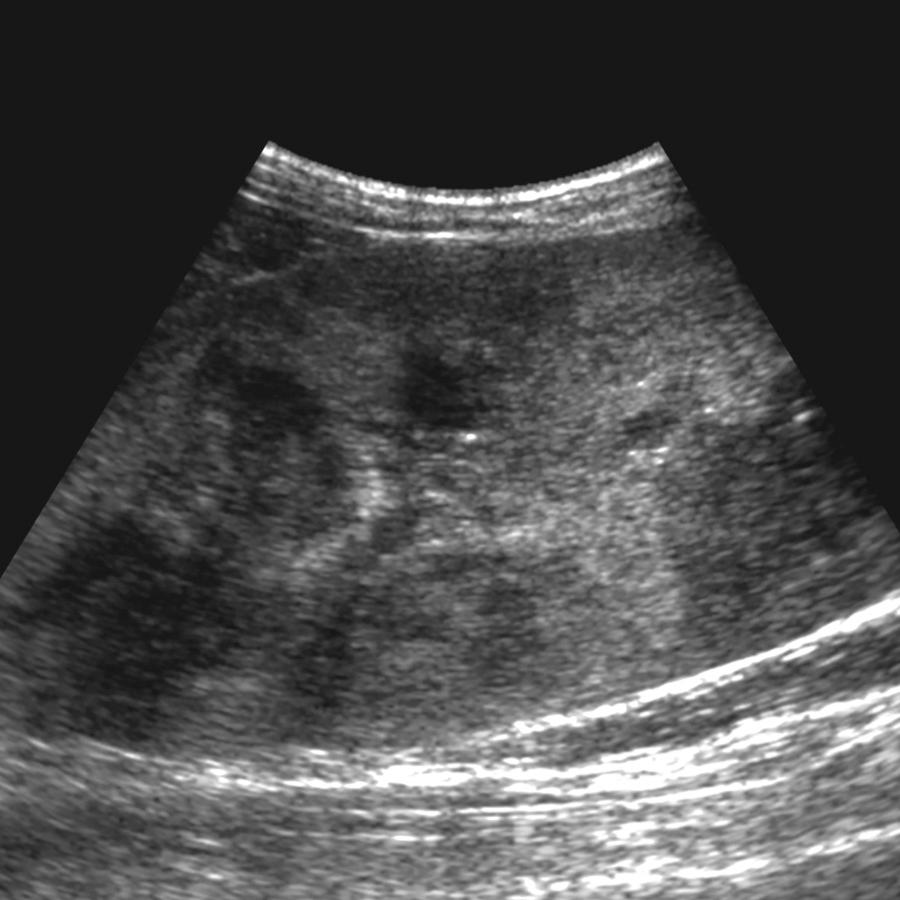
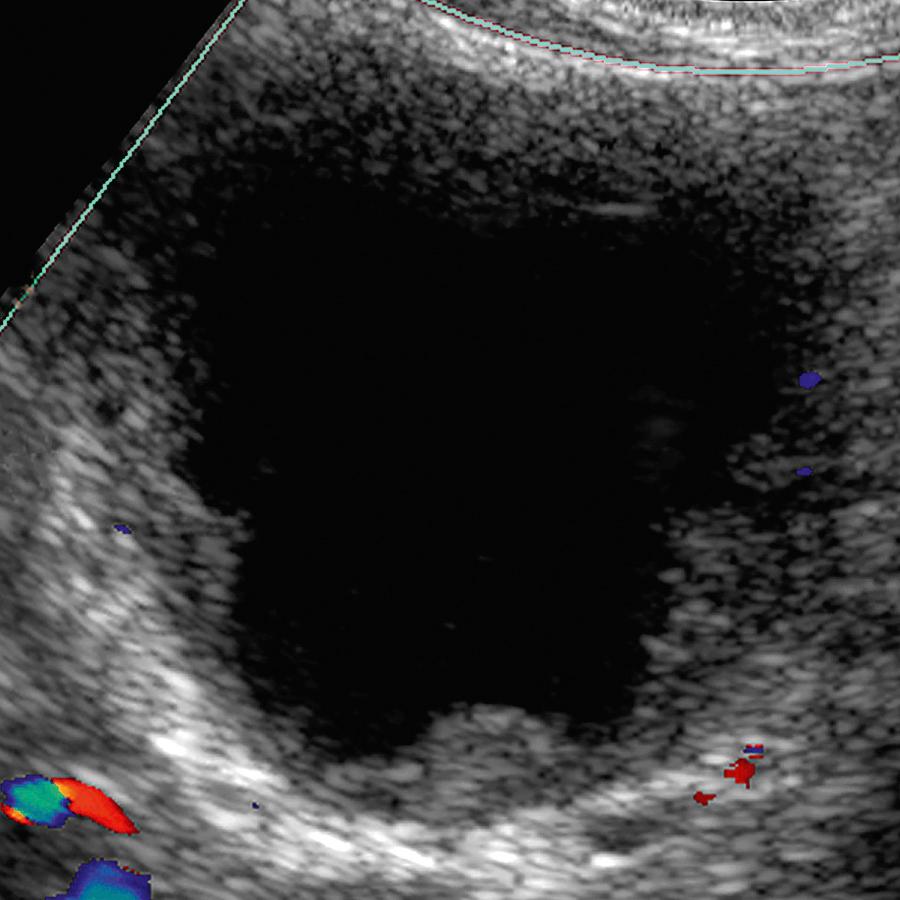
The later or more chronic changes of genitourinary tract TB include fibrotic strictures, extensive cavitation, calcification, mass lesions, perinephric abscesses, and fistulas. The chronic changes, in particular those related to fibrotic strictures, result in functional renal damage. Strictures may occur anywhere in the intrarenal collecting system and ureter. The obstruction then results in proximal collecting system dilatation and pressure atrophy of the renal parenchyma. With time, calcification in the areas of caseation or sloughed papilla may occur. If renal infection ruptures into the perinephric space, an abscess may develop. Perinephric abscesses may ultimately result in fistulas to adjacent viscera. The hallmark of chronic, upper tract renal TB is a small, nonfunctional, calcified kidney, the “putty” kidney. In the bladder, chronic infection and fibrosis result in a thickened, small-capacity bladder. Speckled or curvilinear calcification of the bladder wall may rarely occur.
Most cases of genitourinary tract TB can be diagnosed with a combination of intravenous/retrograde urography, ultrasound, CT, and CT urography. Premkumar et al. demonstrated in 14 patients with advanced urinary tract TB that detailed morphologic information and functional renal status are best assessed with CT and urography. Das et al. reported that ultrasound-guided, fine-needle aspiration (1) may be diagnostic in patients with negative urine cultures and (2) may confirm a diagnosis of upper genitourinary tract TB in those patients with suspicious lesions and positive cultures.
Become a Clinical Tree membership for Full access and enjoy Unlimited articles
If you are a member. Log in here